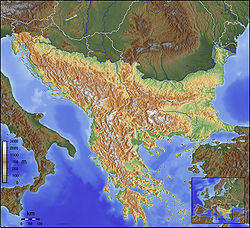Athens
Athens
Greek: Αθήνα | |
|---|---|
Capital city | |
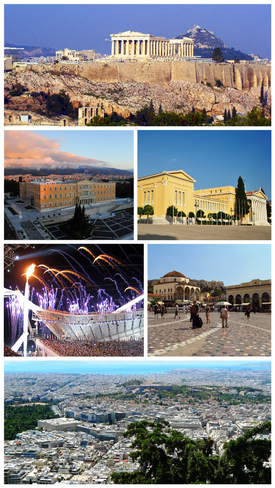  Clockwise from top: Acropolis of Athens, Zappeion Hall, Monastiraki, Aerial view from Lycabettus, Athens Olympic Sports Complex, and Hellenic Parliament | |
 Flag  Seal | |
| Nicknames: Ιοστεφές άστυ (the violet-crowned city) Το κλεινόν άστυ (the glorious city) | |
 Athens Location within Greece | |
| Coordinates: 37°59′03″N 23°43′41″E / 37.98417°N 23.72806°ECoordinates: 37°59′03″N 23°43′41″E / 37.98417°N 23.72806°E | |
| Country | |
| Geographic region | Central Greece |
| Administrative region | Attica |
| Regional unit | Central Athens |
| Districts | 7 |
| Government | |
| • Type | Mayor–council government |
| • Mayor | Kostas Bakoyannis (New Democracy) |
| Area | |
| • Municipality | 38.964 km2 (15.044 sq mi) |
| • Urban | 412 km2 (159 sq mi) |
| • Metro | 2,928.717 km2 (1,130.784 sq mi) |
| Highest elevation | 338 m (1,109 ft) |
| Lowest elevation | 70.1 m (230.0 ft) |
| Population (2012)[2] | |
| • Municipality | 664,046 |
| • Rank | 1st urban, 1st metro in Greece |
| • Urban | 3,090,508 |
| • Urban density | 7,500/km2 (19,000/sq mi) |
| • Metro | 3,753,783[1] |
| Demonym(s) | Athenian |
| GDP PPP (2016) | |
| • Total | US$ 102,446 billion |
| • Per capita | US$ 32,461 |
| Time zone | UTC+2 (EET) |
| • Summer (DST) | UTC+3 (EEST) |
| Postal codes | 10x xx, 11x xx, 120 xx |
| Telephone | 21 |
| Vehicle registration | Yxx, Zxx, Ixx |
| Patron saint | Dionysius the Areopagite (3 October) |
| Website | www.cityofathens.gr |
Athens (/ˈæθənz/ ATH-ənz;[4] Greek: Αθήνα, romanized: Athína [aˈθina] (![]() listen); Ancient Greek: Ἀθῆναι, romanized: Athênai (pl.) [atʰɛ̂ːnai̯]) is the capital and largest city of Greece. Athens dominates the Attica region and is one of the world's oldest cities, with its recorded history spanning over 3,400 years[5] and its earliest human presence starting somewhere between the 11th and 7th millennium BC.[6]
listen); Ancient Greek: Ἀθῆναι, romanized: Athênai (pl.) [atʰɛ̂ːnai̯]) is the capital and largest city of Greece. Athens dominates the Attica region and is one of the world's oldest cities, with its recorded history spanning over 3,400 years[5] and its earliest human presence starting somewhere between the 11th and 7th millennium BC.[6]
Classical Athens was a powerful city-state. It was a center for the arts, learning and philosophy, and the home of Plato's Academy and Aristotle's Lyceum.[7][8] It is widely referred to as the cradle of Western civilization and the birthplace of democracy,[9][10] largely because of its cultural and political impact on the European continent—particularly Ancient Rome.[11] In modern times, Athens is a large cosmopolitan metropolis and central to economic, financial, industrial, maritime, political and cultural life in Greece. In 2021, Athens' urban area hosted more than three and a half million people, which is around 35% of the entire population of Greece.
Athens is a Beta global city according to the Globalization and World Cities Research Network,[12] and is one of the biggest economic centers in southeastern Europe. It has a large financial sector, and its port Piraeus is both the largest passenger port in Europe,[13][14] and the second largest in the world.[15]
The Municipality of Athens (also City of Athens), which actually constitutes a small administrative unit of the entire city, had a population of 664,046 (in 2011)[2] within its official limits, and a land area of 38.96 km2 (15.04 sq mi).[16][17] The Athens Urban Area or Greater Athens[18] extends beyond its administrative municipal city limits, with a population of 3,090,508 (in 2011)[19] over an area of 412 km2 (159 sq mi).[17] According to Eurostat[20] in 2011, the functional urban area of Athens was the 9th most populous in the European Union (the 6th most populous capital city of the EU), with a population of 3.8 million people. Athens is also the southernmost capital on the European mainland and the warmest major city in Europe.
The heritage of the classical era is still evident in the city, represented by ancient monuments and works of art, the most famous of all being the Parthenon, considered a key landmark of early Western civilization. The city also retains Roman and Byzantine monuments, as well as a smaller number of Ottoman monuments, while its historical urban core features elements of continuity through its millennia of history.[21] Athens is home to two UNESCO World Heritage Sites, the Acropolis of Athens and the medieval Daphni Monastery. Landmarks of the modern era, dating back to the establishment of Athens as the capital of the independent Greek state in 1834, include the Hellenic Parliament and the so-called "architectural trilogy of Athens", consisting of the National Library of Greece, the National and Kapodistrian University of Athens and the Academy of Athens. Athens is also home to several museums and cultural institutions, such as the National Archeological Museum, featuring the world's largest collection of ancient Greek antiquities, the Acropolis Museum, the Museum of Cycladic Art, the Benaki Museum and the Byzantine and Christian Museum. Athens was the host city of the first modern-day Olympic Games in 1896, and 108 years later it hosted the 2004 Summer Olympics, making it one of the few cities to have hosted the Olympics more than once.[22]
Etymology and names[]
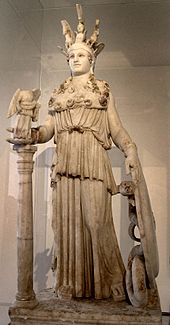
In Ancient Greek, the name of the city was Ἀθῆναι (Athênai, pronounced [atʰɛ̂ːnai̯] in Classical Attic) a plural. In earlier Greek, such as Homeric Greek, the name had been current in the singular form though, as Ἀθήνη (Athḗnē).[23] It was possibly rendered in the plural later on, like those of Θῆβαι (Thêbai) and Μυκῆναι (Μukênai). The root of the word is probably not of Greek or Indo-European origin,[24] and is possibly a remnant of the Pre-Greek substrate of Attica.[24] In antiquity, it was debated whether Athens took its name from its patron goddess Athena (Attic Ἀθηνᾶ, Athēnâ, Ionic Ἀθήνη, Athḗnē, and Doric Ἀθάνα, Athā́nā) or Athena took her name from the city.[25] Modern scholars now generally agree that the goddess takes her name from the city,[25] because the ending -ene is common in names of locations, but rare for personal names.[25]
According to the ancient Athenian founding myth, Athena, the goddess of wisdom, competed against Poseidon, the God of the Seas, for patronage of the yet-unnamed city;[26] they agreed that whoever gave the Athenians the better gift would become their patron[26] and appointed Cecrops, the king of Athens, as the judge.[26] According to the account given by Pseudo-Apollodorus, Poseidon struck the ground with his trident and a salt water spring welled up.[26] In an alternative version of the myth from Vergil's Georgics, Poseidon instead gave the Athenians the first horse.[26] In both versions, Athena offered the Athenians the first domesticated olive tree.[26][27] Cecrops accepted this gift[26] and declared Athena the patron goddess of Athens.[26][27] Eight different etymologies, now commonly rejected, were proposed during the 17th century.[citation needed] Christian Lobeck proposed as the root of the name the word ἄθος (áthos) or ἄνθος (ánthos) meaning "flower", to denote Athens as the "flowering city". Ludwig von Döderlein proposed the stem of the verb θάω, stem θη- (tháō, thē-, "to suck") to denote Athens as having fertile soil.[28] Athenians were called cicada-wearers (Ancient Greek: Τεττιγοφόροι) because they used to wear pins of golden cicadas. A symbol of being autochthon (earth-born), because the legendary founder of Athens, Erechtheus was an autochthon or of being musicians, because the cicada is a "musician" insect.[29] In classical literature, the city was sometimes referred to as the City of the Violet Crown, first documented in Pindar's ἰοστέφανοι Ἀθᾶναι (iostéphanoi Athânai), or as τὸ κλεινὸν ἄστυ (tò kleinòn ásty, "the glorious city").
During the medieval period, the name of the city was rendered once again in the singular as Ἀθήνα. Variant names included Setines, Satine, and Astines, all derivations involving false splitting of prepositional phrases.[30] King Alphonse X of Castile gives the pseudo-etymology 'the one without death/ignorance'.[31][page needed] In Ottoman Turkish, it was called آتينا Ātīnā,[32] and in modern Turkish, it is Atina.
After the establishment of the modern Greek state, and partly due to the conservatism of the written language, Ἀθῆναι [aˈθine] again became the official name of the city and remained so until the abandonment of Katharevousa in the 1970s, when Ἀθήνα, Athína, became the official name. Today it is often simply called η πρωτεύουσα ī protévousa ; 'the capital'.
History[]
The oldest known human presence in Athens is the Cave of Schist, which has been dated to between the 11th and 7th millennia BC.[6] Athens has been continuously inhabited for at least 5,000 years (3000 BC).[33][34] By 1400 BC, the settlement had become an important centre of the Mycenaean civilization, and the Acropolis was the site of a major Mycenaean fortress, whose remains can be recognised from sections of the characteristic Cyclopean walls.[35] Unlike other Mycenaean centers, such as Mycenae and Pylos, it is not known whether Athens suffered destruction in about 1200 BC, an event often attributed to a Dorian invasion, and the Athenians always maintained that they were pure Ionians with no Dorian element. However, Athens, like many other Bronze Age settlements, went into economic decline for around 150 years afterwards.
Iron Age burials, in the Kerameikos and other locations, are often richly provided for and demonstrate that from 900 BC onwards Athens was one of the leading centres of trade and prosperity in the region.[36] The leading position of Athens may well have resulted from its central location in the Greek world, its secure stronghold on the Acropolis and its access to the sea, which gave it a natural advantage over inland rivals such as Thebes and Sparta.

By the 6th century BC, widespread social unrest led to the reforms of Solon. These would pave the way for the eventual introduction of democracy by Cleisthenes in 508 BC. Athens had by this time become a significant naval power with a large fleet, and helped the rebellion of the Ionian cities against Persian rule. In the ensuing Greco-Persian Wars Athens, together with Sparta, led the coalition of Greek states that would eventually repel the Persians, defeating them decisively at Marathon in 490 BC, and crucially at Salamis in 480 BC. However, this did not prevent Athens from being captured and sacked twice by the Persians within one year, after a heroic but ultimately failed resistance at Thermopylae by Spartans and other Greeks led by King Leonidas,[37] after both Boeotia and Attica fell to the Persians.
The decades that followed became known as the Golden Age of Athenian democracy, during which time Athens became the leading city of Ancient Greece, with its cultural achievements laying the foundations for Western civilization. The playwrights Aeschylus, Sophocles and Euripides flourished in Athens during this time, as did the historians Herodotus and Thucydides, the physician Hippocrates, and the philosopher Socrates. Guided by Pericles, who promoted the arts and fostered democracy, Athens embarked on an ambitious building program that saw the construction of the Acropolis of Athens (including the Parthenon), as well as empire-building via the Delian League. Originally intended as an association of Greek city-states to continue the fight against the Persians, the league soon turned into a vehicle for Athens's own imperial ambitions. The resulting tensions brought about the Peloponnesian War (431–404 BC), in which Athens was defeated by its rival Sparta.
By the mid-4th century BC, the northern Greek kingdom of Macedon was becoming dominant in Athenian affairs. In 338 BC the armies of Philip II defeated an alliance of some of the Greek city-states including Athens and Thebes at the Battle of Chaeronea, effectively ending Athenian independence. Later, under Rome, Athens was given the status of a free city because of its widely admired schools. The Roman emperor Hadrian, in the 2nd century AD, ordered the construction of a library, a gymnasium, an aqueduct which is still in use, several temples and sanctuaries, a bridge and financed the completion of the Temple of Olympian Zeus.
By the end of Late Antiquity, Athens had shrunk due to sacks by the Herulians, Visigoths, and Early Slavs which caused massive destruction in the city. In this era, the first Christian churches were built in Athens, and the Parthenon and other temples were converted into churches. Athens expanded its settlement in the second half of the Middle Byzantine Period, in the 9th to 10th centuries AD, and was relatively prosperous during the Crusades, benefiting from Italian trade. After the Fourth Crusade the Duchy of Athens was established. In 1458 it was conquered by the Ottoman Empire and entered a long period of decline.
Following the Greek War of Independence and the establishment of the Greek Kingdom, Athens was chosen as the capital of the newly independent Greek state in 1834, largely because of historical and sentimental reasons. At the time, it was reduced to a town of about 4,000 people in a loose swarm of houses along the foot of the Acropolis. The first King of Greece, Otto of Bavaria, commissioned the architects Stamatios Kleanthis and Eduard Schaubert to design a modern city plan fit for the capital of a state.
The first modern city plan consisted of a triangle defined by the Acropolis, the ancient cemetery of Kerameikos and the new palace of the Bavarian king (now housing the Greek Parliament), so as to highlight the continuity between modern and ancient Athens. Neoclassicism, the international style of this epoch, was the architectural style through which Bavarian, French and Greek architects such as Hansen, Klenze, Boulanger or Kaftantzoglou designed the first important public buildings of the new capital. In 1896, Athens hosted the first modern Olympic Games. During the 1920s a number of Greek refugees, expelled from Asia Minor after the Greco-Turkish War and Greek genocide, swelled Athens's population; nevertheless it was most particularly following World War II, and from the 1950s and 1960s, that the population of the city exploded, and Athens experienced a gradual expansion.
In the 1980s it became evident that smog from factories and an ever-increasing fleet of automobiles, as well as a lack of adequate free space due to congestion, had evolved into the city's most important challenge. A series of anti-pollution measures taken by the city's authorities in the 1990s, combined with a substantial improvement of the city's infrastructure (including the Attiki Odos motorway, the expansion of the Athens Metro, and the new Athens International Airport), considerably alleviated pollution and transformed Athens into a much more functional city. In 2004 Athens hosted the 2004 Summer Olympics.

Tondo of the Aison Cup, showing the victory of Theseus over the Minotaur in the presence of Athena. Theseus was responsible, according to the myth, for the synoikismos ("dwelling together")—the political unification of Attica under Athens.

The earliest coinage of Athens, c. 545–525/15 BC

Coat of Arms of the Duchy of Athens during the rule of the de la Roche family (13th century)

The Roman Agora and the Gate of Athena in Plaka district.

The Temple of Olympian Zeus with river Ilisos by Edward Dodwell, 1821

The Entry of King Otto in Athens, Peter von Hess, 1839.
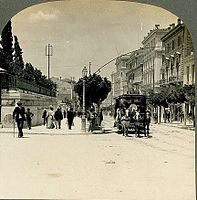
The Stadiou Street in Central Athens in 1908.
Geography[]
Athens sprawls across the central plain of Attica that is often referred to as the Athens Basin or the Attica Basin (Greek: Λεκανοπέδιο Αθηνών/Αττικής). The basin is bounded by four large mountains: Mount Aigaleo to the west, Mount Parnitha to the north, Mount Pentelicus to the northeast and Mount Hymettus to the east.[38] Beyond Mount Aegaleo lies the Thriasian plain, which forms an extension of the central plain to the west. The Saronic Gulf lies to the southwest. Mount Parnitha is the tallest of the four mountains (1,413 m (4,636 ft)),[39] and has been declared a national park. The city is located in the north temperate zone, 38 degrees north of the equator.
Athens is built around a number of hills. Lycabettus is one of the tallest hills of the city proper and provides a view of the entire Attica Basin. The meteorology of Athens is deemed to be one of the most complex in the world because its mountains cause a temperature inversion phenomenon which, along with the Greek Government's difficulties controlling industrial pollution, was responsible for the air pollution problems the city has faced.[34] This issue is not unique to Athens; for instance, Los Angeles and Mexico City also suffer from similar atmospheric inversion problems.[34]
The Cephissus river, the Ilisos and the Eridanos stream are the historical rivers of Athens.
Environment[]

By the late 1970s, the pollution of Athens had become so destructive that according to the then Greek Minister of Culture, Constantine Trypanis, "...the carved details on the five the caryatids of the Erechtheum had seriously degenerated, while the face of the horseman on the Parthenon's west side was all but obliterated."[40] A series of measures taken by the authorities of the city throughout the 1990s resulted in the improvement of air quality; the appearance of smog (or nefos as the Athenians used to call it) has become less common.
Measures taken by the Greek authorities throughout the 1990s have improved the quality of air over the Attica Basin. Nevertheless, air pollution still remains an issue for Athens, particularly during the hottest summer days. In late June 2007,[41] the Attica region experienced a number of brush fires,[41] including a blaze that burned a significant portion of a large forested national park in Mount Parnitha,[42] considered critical to maintaining a better air quality in Athens all year round.[41] Damage to the park has led to worries over a stalling in the improvement of air quality in the city.[41]
The major waste management efforts undertaken in the last decade (particularly the plant built on the small island of Psytalia) have greatly improved water quality in the Saronic Gulf, and the coastal waters of Athens are now accessible again to swimmers. In January 2007, Athens faced a waste management problem when its landfill near Ano Liosia, an Athenian suburb, reached capacity.[43] The crisis eased by mid-January when authorities began taking the garbage to a temporary landfill.[43]
Safety[]
Athens ranks in the lowest percentage for the risk on frequency and severity of terrorist attacks according to the EU Global Terrorism Database (EIU 2007–2016 calculations). The city also ranked 35th in Digital Security, 21st on Health Security, 29th on Infrastructure Security and 41st on Personal Security globally in a 2017 The Economist Intelligence Unit report.[44] It also ranks as a very safe city (39th globally out of 162 cities overall) on the ranking of the safest and most dangerous countries.[45] A 2019 crime index from Numbeo places Athens at 130th position, rating safer than Tampa, Florida or Dublin, Ireland.[46] According to a Mercer 2019 Quality of Living Survey, Athens ranks 89th on the Mercer Quality of Living Survey ranking.[47]
Climate[]
Athens has a hot-summer Mediterranean climate (Köppen climate classification: Csa). The dominant feature of Athens' climate is alternation between prolonged hot and dry summers because of the dry and hot winds blowing from the Sahara, and mild, wetter winters with moderate rainfall, due to the westerly winds.[48] With an average of 433 millimetres (17.0 in) of yearly precipitation, rainfall occurs largely between the months of October and April. July and August are the driest months when thunderstorms occur sparsely. Furthermore, some coastal areas of Athens, known as the Athens Riviera have a hot semi-arid climate (BSh) according to the climate atlas published by the Hellenic National Meteorological Service.[49] However, places like Elliniko, which are classified as hot semi-arid (BSh) because of the low annual rainfall, have not recorded temperatures as high as other places in the city. This happens because of the moderating sea and the fact that there is not as much industrialization as in other regions of the city.[citation needed]
Owing to the rain shadow of the Pindus Mountains, annual precipitation of Athens is lower than most other parts of Greece, especially western Greece. As an example, Ioannina receives around 1,300 mm (51 in) per year, and Agrinio around 800 mm (31 in) per year. Daily average highs for July have been measured around 34 °C or 93 °F in downtown Athens, but some parts of the city may be even hotter for the higher density of buildings, and the lower density of vegetation, such as the center,[50] in particular, western areas due to a combination of industrialization and a number of natural factors, knowledge of which has existed since the mid-19th century.[51][52][53] Due to the large area covered by Athens Metropolitan Area, there are notable climatic differences between parts of the urban conglomeration. The northern suburbs tend to be wetter and cooler in winter, whereas the southern suburbs are some of the driest locations in Greece and record very high minimum temperatures in summer. Snowfall is infrequent. The last time snow fell in Athens was 16 February 2021; snow blanketed the city from the north to the very south suburbs with depth ranges from 5 cm to 25 cm.

Athens is affected by the urban heat island effect in some areas which is caused by human activity,[54][55] altering its temperatures compared to the surrounding rural areas,[56][57][58][59] and leaving detrimental effects on energy usage, expenditure for cooling,[60][61] and health.[55] The urban heat island of the city has also been found to be partially responsible for alterations of the climatological temperature time-series of specific Athens meteorological stations, because of its impact on the temperatures and the temperature trends recorded by some meteorological stations.[62][63][64][65][66] On the other hand, specific meteorological stations, such as the National Garden station and Thiseio meteorological station, are less affected or do not experience the urban heat island.[56][67]
Athens holds the World Meteorological Organization record for the highest temperature ever recorded in Europe, at 48 °C (118.4 °F), which was recorded in the Elefsina and Tatoi suburbs of Athens on 10 July 1977.[68]
| hideClimate data for Downtown Athens (1991–2020), Extremes (1890–present) | |||||||||||||
|---|---|---|---|---|---|---|---|---|---|---|---|---|---|
| Month | Jan | Feb | Mar | Apr | May | Jun | Jul | Aug | Sep | Oct | Nov | Dec | Year |
| Record high °C (°F) | 22.6 (72.7) |
25.3 (77.5) |
28.9 (84.0) |
32.2 (90.0) |
38.4 (101.1) |
44.8 (112.6) |
43.0 (109.4) |
42.6 (108.7) |
38.6 (101.5) |
36.5 (97.7) |
30.5 (86.9) |
22.9 (73.2) |
44.8 (112.6) |
| Average high °C (°F) | 13.3 (55.9) |
14.2 (57.6) |
17.0 (62.6) |
21.1 (70.0) |
26.5 (79.7) |
31.6 (88.9) |
34.3 (93.7) |
34.3 (93.7) |
29.6 (85.3) |
24.4 (75.9) |
18.9 (66.0) |
14.4 (57.9) |
23.3 (73.9) |
| Daily mean °C (°F) | 10.2 (50.4) |
10.8 (51.4) |
13.1 (55.6) |
16.7 (62.1) |
21.8 (71.2) |
26.6 (79.9) |
29.3 (84.7) |
29.4 (84.9) |
25.0 (77.0) |
20.3 (68.5) |
15.6 (60.1) |
11.6 (52.9) |
19.2 (66.6) |
| Average low °C (°F) | 7.1 (44.8) |
7.3 (45.1) |
9.2 (48.6) |
12.3 (54.1) |
17.0 (62.6) |
21.6 (70.9) |
24.2 (75.6) |
24.4 (75.9) |
20.4 (68.7) |
16.2 (61.2) |
12.2 (54.0) |
8.7 (47.7) |
15.0 (59.0) |
| Record low °C (°F) | −6.5 (20.3) |
−5.7 (21.7) |
−2.6 (27.3) |
1.7 (35.1) |
6.2 (43.2) |
11.8 (53.2) |
16 (61) |
15.5 (59.9) |
8.9 (48.0) |
5.9 (42.6) |
−1.1 (30.0) |
−4.0 (24.8) |
−6.5 (20.3) |
| Average rainfall mm (inches) | 55.6 (2.19) |
44.4 (1.75) |
45.6 (1.80) |
27.6 (1.09) |
20.7 (0.81) |
11.6 (0.46) |
10.7 (0.42) |
5.4 (0.21) |
25.8 (1.02) |
38.6 (1.52) |
70.8 (2.79) |
76.3 (3.00) |
433.1 (17.06) |
| Average relative humidity (%) | 72.0 | 70.0 | 66.0 | 60.0 | 56.0 | 50.0 | 42.0 | 47.0 | 57.0 | 66.0 | 72.0 | 73.0 | 60.9 |
| Source 1: Cosmos, scientific magazine of the National Observatory of Athens[69] | |||||||||||||
| Source 2: Meteoclub[70][71] | |||||||||||||
| showClimate data for Elliniko, Athens (1955–2010), Extremes (1961–present) |
|---|
| showClimate data for Nea Filadelfia, Athens (1955–2010) |
|---|
Locations[]
Neighbourhoods of the Center of Athens (Municipality of Athens)[]

The Municipality of Athens, the City Centre of the Athens Urban Area, is divided into several districts: Omonoia, Syntagma, Exarcheia, Agios Nikolaos, Neapolis, Lykavittos, Lofos Strefi, Lofos Finopoulou, Lofos Filopappou, Pedion Areos, Metaxourgeio, Aghios Kostantinos, Larissa Station, Kerameikos, Psiri, Monastiraki, Gazi, Thission, Kapnikarea, Aghia Irini, Aerides, Anafiotika, Plaka, Acropolis, Pnyka, Makrygianni, Lofos Ardittou, Zappeion, Aghios Spyridon, Pangrati, Kolonaki, Dexameni, Evaggelismos, Gouva, Aghios Ioannis, Neos Kosmos, Koukaki, Kynosargous, Fix, Ano Petralona, Kato Petralona, Rouf, Votanikos, Profitis Daniil, Akadimia Platonos, Kolonos, Kolokynthou, Attikis Square, Lofos Skouze, Sepolia, Kypseli, Aghios Meletios, Nea Kypseli, Gyzi, Polygono, Ampelokipoi, Panormou-Gerokomeio, Pentagono, Ellinorosson, Nea Filothei, Ano Kypseli, Tourkovounia-Lofos Patatsou, Lofos Elikonos, Koliatsou, Thymarakia, Kato Patisia, Treis Gefyres, Aghios Eleftherios, Ano Patisia, Kypriadou, Menidi, Prompona, Aghios Panteleimonas, Pangrati, Goudi, Vyronas and Ilisia.
- Omonoia, Omonoia Square, (Greek: Πλατεία Ομονοίας) is the oldest square in Athens. It is surrounded by hotels and fast food outlets, and contains a metro station, named Omonia station. The square is the focus for celebration of sporting victories, as seen after the country's winning of the Euro 2004 and the EuroBasket 2005 tournaments.
 Aiolou Street in the centre. On the left is the building of the National Bank of Greece.
Aiolou Street in the centre. On the left is the building of the National Bank of Greece. - Metaxourgeio (Greek: Μεταξουργείο) is a neighborhood of Athens. The neighborhood is located north of the historical centre of Athens, between Kolonos to the east and Kerameikos to the west, and north of Gazi. Metaxourgeio is frequently described as a transition neighborhood. After a long period of abandonment in the late 20th century, the area is acquiring a reputation as an artistic and fashionable neighborhood following the opening of art galleries, museums, restaurants and cafés. [1] Local efforts to beautify and invigorate the neighborhood have reinforced a sense of community and artistic expression. Anonymous art pieces containing quotes and statements in both English and Ancient Greek have sprung up throughout the neighborhood, bearing statements such as "Art for art's sake" (Τέχνη τέχνης χάριν). Guerrilla gardening has also helped to beautify the area.
 Apartment buildings near Kolonaki Square.
Apartment buildings near Kolonaki Square. - Psiri – The reviving Psiri (Greek: Ψυρρή) neighbourhood – also known as Athens's "meat packing district" – is dotted with renovated former mansions, artists' spaces, and small gallery areas. A number of its renovated buildings also host fashionable bars, making it a hotspot for the city in the last decade, while live music restaurants known as "rebetadika", after rebetiko, a unique form of music that blossomed in Syros and Athens from the 1920s until the 1960s, are to be found. Rebetiko is admired by many, and as a result rebetadika are often crammed with people of all ages who will sing, dance and drink till dawn.
- The Gazi (Greek: Γκάζι) area, one of the latest in full redevelopment, is located around a historic gas factory, now converted into the Technopolis cultural multiplex, and also includes artists' areas, small clubs, bars and restaurants, as well as Athens's "Gay village". The metro's expansion to the western suburbs of the city has brought easier access to the area since spring 2007, as the line 3 now stops at Gazi (Kerameikos station).
- Syntagma, Syntagma Square, (Greek: Σύνταγμα/Constitution Square), is the capital's central and largest square, lying adjacent to the Greek Parliament (the former Royal Palace) and the city's most notable hotels. Ermou Street, an approximately one-kilometre-long (5⁄8-mile) pedestrian road connecting Syntagma Square to Monastiraki, is a consumer paradise for both Athenians and tourists. Complete with fashion shops and shopping centres promoting most international brands, it now finds itself in the top five most expensive shopping streets in Europe, and the tenth most expensive retail street in the world.[77] Nearby, the renovated Army Fund building in Panepistimiou Street includes the "Attica" department store and several upmarket designer stores.
 Neoclassical houses in the historical neighbourhood of Plaka.
Neoclassical houses in the historical neighbourhood of Plaka. - Plaka, Monastiraki, and Thission – Plaka (Greek: Πλάκα), lying just beneath the Acropolis, is famous for its plentiful neoclassical architecture, making up one of the most scenic districts of the city. It remains a prime tourist destination with tavernas, live performances and street salesmen. Nearby Monastiraki (Greek: Μοναστηράκι), for its part, is known for its string of small shops and markets, as well as its crowded flea market and tavernas specialising in souvlaki. Another district known for its student-crammed, stylish cafés is Theseum or Thission (Greek: Θησείο), lying just west of Monastiraki. Thission is home to the ancient Temple of Hephaestus, standing atop a small hill. This area also has a picturesque 11th-century Byzantine church, as well as a 15th-century Ottoman mosque.
- Exarcheia (Greek: Εξάρχεια), located north of Kolonaki, often regarded as the city's anarchist scene and as a student quarter with cafés, bars and bookshops. Exarcheia is home to the Athens Polytechnic and the National Archaeological Museum; it also contains important buildings of several 20th-century styles: Neoclassicism, Art Deco and Early Modernism (including Bauhaus influences).[citation needed]
- Kolonaki (Greek: Κολωνάκι) is the area at the base of Lycabettus hill, full of boutiques catering to well-heeled customers by day, and bars and more fashionable restaurants by night, with galleries and museums. This is often regarded as one of the more prestigious areas of the capital.
Parks and zoos[]
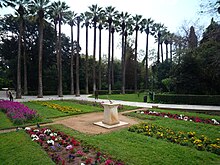
Parnitha National Park is punctuated by well-marked paths, gorges, springs, torrents and caves dotting the protected area. Hiking and mountain-biking in all four mountains are popular outdoor activities for residents of the city. The National Garden of Athens was completed in 1840 and is a green refuge of 15.5 hectares in the centre of the Greek capital. It is to be found between the Parliament and Zappeion buildings, the latter of which maintains its own garden of seven hectares.
Parts of the City Centre have been redeveloped under a masterplan called the Unification of Archeological Sites of Athens, which has also gathered funding from the EU to help enhance the project.[78][79] The landmark Dionysiou Areopagitou Street has been pedestrianised, forming a scenic route. The route starts from the Temple of Olympian Zeus at Vasilissis Olgas Avenue, continues under the southern slopes of the Acropolis near Plaka, and finishes just beyond the Temple of Hephaestus in Thiseio. The route in its entirety provides visitors with views of the Parthenon and the Agora (the meeting point of ancient Athenians), away from the busy City Centre.
The hills of Athens also provide green space. Lycabettus, Philopappos hill and the area around it, including Pnyx and , are planted with pines and other trees, with the character of a small forest rather than typical metropolitan parkland. Also to be found is the Pedion tou Areos (Field of Mars) of 27.7 hectares, near the National Archaeological Museum.
Athens' largest zoo is the Attica Zoological Park, a 20-hectare (49-acre) private zoo located in the suburb of Spata. The zoo is home to around 2000 animals representing 400 species, and is open 365 days a year. Smaller zoos exist within public gardens or parks, such as the zoo within the National Garden of Athens.
Urban and suburban municipalities[]


The Athens Metropolitan Area consists of 58[19] densely populated municipalities, sprawling around the Municipality of Athens (the City Centre) in virtually all directions. For the Athenians, all the urban municipalities surrounding the City Centre are called suburbs. According to their geographic location in relation to the City of Athens, the suburbs are divided into four zones; the northern suburbs (including Agios Stefanos, Dionysos, Ekali, Nea Erythraia, Kifissia, Kryoneri, Maroussi, Pefki, Lykovrysi, Metamorfosi, Nea Ionia, Nea Filadelfeia, Irakleio, Vrilissia, Melissia, Penteli, Chalandri, Agia Paraskevi, Gerakas, Pallini, Galatsi, Psychiko and Filothei); the southern suburbs (including Alimos, Nea Smyrni, Moschato, Tavros, Agios Ioannis Rentis, Kallithea, Piraeus, Agios Dimitrios, Palaio Faliro, Elliniko, Glyfada, Lagonisi, Saronida, Argyroupoli, Ilioupoli, Varkiza, Voula, Vari and Vouliagmeni); the eastern suburbs (including Zografou, Dafni, Vyronas, Kaisariani, Cholargos and Papagou); and the western suburbs (including Peristeri, Ilion, Egaleo, Koridallos, Agia Varvara, Keratsini, Perama, Nikaia, Drapetsona, Chaidari, Petroupoli, Agioi Anargyroi, Ano Liosia, Aspropyrgos, Eleusina, Acharnes and Kamatero).
The Athens city coastline, extending from the major commercial port of Piraeus to the southernmost suburb of Varkiza for some 25 km (20 mi),[80] is also connected to the City Centre by tram.
In the northern suburb of Maroussi, the upgraded main Olympic Complex (known by its Greek acronym OAKA) dominates the skyline. The area has been redeveloped according to a design by the Spanish architect Santiago Calatrava, with steel arches, landscaped gardens, fountains, futuristic glass, and a landmark new blue glass roof which was added to the main stadium. A second Olympic complex, next to the sea at the beach of Palaio Faliro, also features modern stadia, shops and an elevated esplanade. Work is underway to transform the grounds of the old Athens Airport – named Elliniko – in the southern suburbs, into one of the largest landscaped parks in Europe, to be named the Hellenikon Metropolitan Park.[81]
Many of the southern suburbs (such as Alimos, Palaio Faliro, Elliniko, Glyfada, Voula, Vouliagmeni and Varkiza) known as the Athens Riviera, host a number of sandy beaches, most of which are operated by the Greek National Tourism Organisation and require an entrance fee. Casinos operate on both Mount Parnitha, some 25 km (16 mi)[82] from downtown Athens (accessible by car or cable car), and the nearby town of Loutraki (accessible by car via the Athens – Corinth National Highway, or the suburban rail service Proastiakos).
Administration[]

The large City Centre (Greek: Κέντρο της Αθήνας) of the Greek capital falls directly within the Municipality of Athens or Athens Municipality (Greek: Δήμος Αθηναίων)—also City of Athens. Athens Municipality is the largest in population size in Greece. Piraeus also forms a significant city centre on its own,[83] within the Athens Urban Area and it is the second largest in population size within it, with Peristeri, Kallithea and Kypseli following.
Athens Urban Area[]
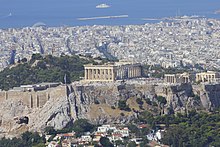
The Athens Urban Area (Greek: Πολεοδομικό Συγκρότημα Αθηνών), also known as Urban Area of the Capital (Greek: Πολεοδομικό Συγκρότημα Πρωτεύουσας) or Greater Athens (Greek: Ευρύτερη Αθήνα),[84] today consists of 40 municipalities, 35 of which make up what was referred to as the former Athens Prefecture municipalities, located within 4 regional units (North Athens, West Athens, Central Athens, South Athens); and a further 5 municipalities, which make up the former Piraeus Prefecture municipalities, located within the regional unit of Piraeus as mentioned above. The densely built up urban area of the Greek capital sprawls across 412 km2 (159 sq mi)[17] throughout the Attica Basin and has a total population of 3,074,160 (in 2011).
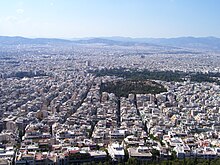
The Athens Municipality forms the core and center of Greater Athens, which in its turn consists of the Athens Municipality and 40 more municipalities, divided in four regional units (Central, North, South and West Athens), accounting for 2,641,511 people (in 2011)[2] within an area of 361 km2 (139 sq mi).[17] Until 2010, which made up the abolished Athens Prefecture and the municipality of Piraeus, the historic Athenian port, with 4 other municipalities make up the regional unit of Piraeus.
The regional units of Central Athens, North Athens, South Athens, West Athens and Piraeus with part of East[85] and West Attica[86] regional units combined make up the continuous Athens Urban Area,[86][87][88] also called the "Urban Area of the Capital" or simply "Athens" (the most common use of the term), spanning over 412 km2 (159 sq mi),[89] with a population of 3,090,508 people as of 2011. The Athens Urban Area is considered to form the city of Athens as a whole, despite its administrative divisions, which is the largest in Greece and one of the most populated urban areas in Europe.
| |||||||||||||||||||||||
|

|
| |||||||||||||||||||||
| |||||||||||||||||||||||
|
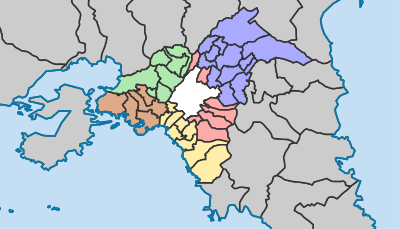
|
Athens Metropolitan Area[]

The Athens Metropolitan Area (Greek: Μητροπολιτική Περιοχή της Αθήνας) spans 2,928.717 km2 (1,131 sq mi) within the Attica region and includes a total of 58 municipalities, which are organized in seven regional units (those outlined above, along with East Attica and West Attica), having reached a population of 3,737,550 based on the preliminary results of the 2011 census. Athens and Piraeus municipalities serve as the two metropolitan centres of the Athens Metropolitan Area.[90] There are also some inter-municipal centres serving specific areas. For example, Kifissia and Glyfada serve as inter-municipal centres for northern and southern suburbs respectively.
Demographics[]
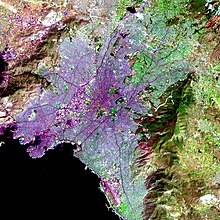
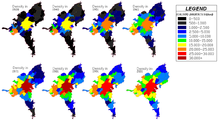
Population in modern times[]

The Municipality of Athens has an official population of 664,046 people.[2] The four regional units that make up what is referred to as Greater Athens have a combined population of 2,640,701. They together with the regional unit of Piraeus (Greater Piraeus) make up the dense Athens Urban Area which reaches a total population of 3,090,508 inhabitants (in 2011).[19] According to Eurostat, in 2013 the functional urban area of Athens had 3,828,434 inhabitants, being apparently decreasing compared with the pre-economic crisis date of 2009 (4,164,175)[20]
The municipality (Center) of Athens is the most populous in Greece, with a population of 664,046 people (in 2011)[2] and an area of 38.96 km2 (15.04 sq mi),[16] forming the core of the Athens Urban Area within the Attica Basin. The incumbent Mayor of Athens is Kostas Bakoyannis of New Democracy. The municipality is divided into seven municipal districts which are mainly used for administrative purposes.
As of the 2011 census, the population for each of the seven municipal districts of Athens is as follows:[91]
- 1st: 75,810
- 2nd: 103,004
- 3rd: 46,508
- 4th: 85,629
- 5th: 98,665
- 6th: 130,582
- 7th: 123,848
For the Athenians the most popular way of dividing the downtown is through its neighbourhoods such as Pagkrati, Ambelokipi, Goudi, Exarcheia, Patissia, Ilissia, Petralona, Plaka, Anafiotika, Koukaki and Kypseli, each with its own distinct history and characteristics.
Population of the Athens Metropolitan Area[]
The Athens Metropolitan Area, with an area of 2,928.717 km2 (1,131 sq mi) and inhabited by 3,753,783 people in 2011,[2] consists of the Athens Urban Area with the addition of the towns and villages of East and West Attica, which surround the dense urban area of the Greek capital. It actually sprawls over the whole peninsula of Attica, which is the best part of the region of Attica, excluding the islands.
| Classification of regional units within Greater Athens, Athens Urban Area and Athens Metropolitan Area | ||||
|---|---|---|---|---|
| Regional unit | Population (2011) | |||
| Central Athens | 1,029,520 | Greater Athens 2,641,511 |
Athens Urban Area 3,090,508 |
Athens Metropolitan Area 3,753,783 |
| North Athens | 592,490 | |||
| South Athens | 529,826 | |||
| West Athens | 489,675 | |||
| Piraeus | 448,997 | Greater Piraeus 448,997 | ||
| East Attica | 502,348 | |||
| West Attica | 160,927 | |||
Population in ancient times[]
Mycenean Athens in 1600–1100 BC could have equalled the size of Tiryns, with an estimated population of up to 10,000–15,000.[92] During the Greek Dark Ages the population of Athens was around 4,000 people, rising to an estimated 10,000 by 700 BC.
During the Classical period Athens denotes both the urban area of the city proper and its subject territory (the Athenian city-state) extending across most of the modern Attica region except the territory of the city-state of Megaris and the island section. In 500 BC the Athenian territory probably contained around 200,000 people. Thucydides indicates a 5th-century total of 150,000-350,000 and up to 610,000. A census ordered by Demetrius of Phalerum in 317 BC is said to have recorded 21,000 free citizens, 10,000 resident aliens and 400,000 slaves, a total population of 431,000,[93] but this figure is highly suspect because of the improbably high number of slaves and does not include free women and children and resident foreigners. An estimate based on Thucydides is 40,000 male citizens, 100,000 family members, 70,000 metics (resident foreigners) and 150,000-400,000 slaves, though modern historians again hesitate to take such high numbers at face value, most estimates now preferring a total in the 200–350,000 range. The urban area of Athens proper (excluding the port of Piraeus) covered less than a thousandth of the area of the city-state, though its population density was of course far higher: modern estimates for the population of the built-up area tend to indicate around 35–45,000 inhabitants, though uncertainties persist around density of occupation, household size and whether there was a significant suburban population beyond the walls.
The ancient site of the main city is centred on the rocky hill of the acropolis. In the whole of Athenian territory they existed many towns. Acharnae, Afidnes, Cytherus, Colonus, Corydallus, Cropia, Decelea, Euonymos, Vravron among others was important towns in Athenian countryside. The new port of Piraeus was a prototype harbour with the infrastructure and housing located in the site between modern passenger section of the port (named Kantharos in ancient times) and the Pasalimani harbour (named Zea in ancient times). The old one Phaliro was in the site of modern Palaio Faliro and gradually declined after the construction of the new prototype port but remained as a minor port and important settlement with historic significance in late Classical times. The rapid expansion of the modern city, which continues to this day, took off with industrial growth in the 1950s and 1960s.[94] The expansion is now particularly toward the East and North East (a tendency greatly related to the new Eleftherios Venizelos International Airport and the Attiki Odos, the freeway that cuts across Attica). By this process Athens has engulfed many former suburbs and villages in Attica, and continues to do so. The table below shows the historical population of Athens in recent times.
| Year | Municipality population | Urban population | Metro population |
|---|---|---|---|
| 1833 | 4,000[95] | – | – |
| 1870 | 44,500[95] | – | – |
| 1896 | 123,000[95] | – | – |
| 1921 (Pre-Population exchange) | 473,000[34] | – | – |
| 1921 (Post-Population exchange) | 718,000[95] | – | – |
| 1971 | 867,023 | – | 2,540,241[96] |
| 1981 | 885,737 | – | 3,369,443 |
| 1991 | 772,072 | 3,444,358 | 3,523,407[97] |
| 2001 | 745,514[98] | 3,165,823[98] | 3,761,810[98] |
| 2011 | 664,046 | 3,181,872 | 3,753,783[19] |
Religion[]
Government and politics[]
Athens became the capital of Greece in 1834, following Nafplion, which was the provisional capital from 1829. The municipality (City) of Athens is also the capital of the Attica region. The term Athens can refer either to the Municipality of Athens, to Greater Athens or urban area, or to the entire Athens Metropolitan Area.

The Hellenic Parliament
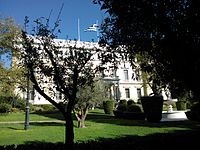
The Presidential Mansion, formerly the Crown Prince Palace, in Herodou Attikou Street.
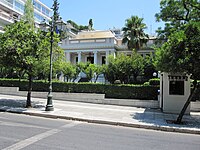
The Maximos Mansion, official office of the Prime Minister of the Hellenic Republic, in Herodou Attikou Street.
The Athens City Hall in Kotzia Square was designed by Panagiotis Kolkas and completed in 1874.[100]
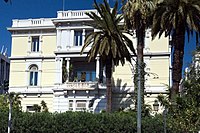
The Embassy of France in Vasilissis Sofias Avenue.

The Italian Embassy in Vasilissis Sofias Avenue.
International relations and influence[]
Twin towns – sister cities[]
Athens is twinned with:[101]
Partnerships[]
- Belgrade, Serbia (1966)[107]
- Paris, France (2000)[108]
- Ljubljana, Slovenia[109]
- Naples, Italy[110]
- Yerevan, Armenia (1993)[111]
Other locations named after Athens[]
- United States
- Athens, Alabama (pop. 24,234)
- Athens, Arkansas[112]
- Athens, California
- West Athens, California (pop. 9,101)
- Athens, Georgia (pop. 114,983)
- Athens, Illinois (pop. 1,726)
- New Athens, Illinois (pop. 2,620)
- New Athens Township, St. Clair County, Illinois (pop. 2,620)
- Athens, Indiana
- Athens, Kentucky
- Athens, Louisiana (pop. 262)
- Athens Township, Jewell County, Kansas (pop. 74)
- Athens, Maine (pop. 847)
- Athens, Michigan (pop. 1,111)
- Athens Township, Michigan (pop. 2,571)
- Athens, Minnesota
- Athens Township, Minnesota (pop. 2,322)
- Athens, Mississippi
- Athens (town), New York (pop. 3,991)
- Athens (village), New York (pop. 1,695)
- Athens, Ohio (pop. 21,909)
- Athens County, Ohio (pop. 62,223)
- Athens Township, Athens County, Ohio (pop. 27,714)
- Athens Township, Harrison County, Ohio (pop. 520)
- New Athens, Ohio (pop. 342)
- Athena, Oregon (pop. 1,270)
- Athens, Pennsylvania (pop. 3,415)
- Athens Township, Bradford County, Pennsylvania (pop. 5,058)
- Athens Township, Crawford County, Pennsylvania (pop. 775)
- Athens, Tennessee (pop. 13,220)
- Athens, Texas (pop. 11,297)
- Athens, Vermont (pop. 340)
- Athens, West Virginia (pop. 1,102)
- Athens, Wisconsin (pop. 1,095)
- Canada
- Athens Township, Ontario (pop. 3,086)
- Costa Rica
- Atenas (pop. 7,716)
- Atenas (canton) (pop. 23,743)
- Germany
- Athenstedt, Saxony-Anhalt (pop. 431)
- Honduras
- Italy
- Atena Lucana, Province of Salerno, Campania (pop. 2,344)
- Atina, Province of Frosinone, Lazio (pop. 4,480)
- Poland
- Ateny, Podlaskie Voivodeship (pop. 40)
- Ukraine
- Afini (Zoria – Зоря), Donetsk (pop. 200)
Economy and infrastructure[]
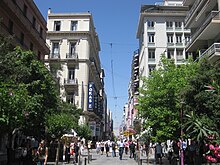
Athens is the financial capital of Greece. According to data from 2014, Athens as a metropolitan economic area produced 130 billion US-dollars as GDP in PPP, which consists nearly a half of the production for the whole country. In the list with the strongest economic metropoles of the world Athens was ranked that year 102nd, while the GDP per capita for the same year was 32,000 US-dollars.[114]
Athens is one of the major economic centres in south-eastern Europe and is considered a regional economic power in Europe generally. The port of Piraeus, where big investments by COSCO have already been delivered during the recent decade, the completion of the new Cargo Centre in Thriasion,[115] the expansion of the Athens Metro and the Athens Tram, as well as the Hellenikon metropolitan park redevelopment in Elliniko and other economic projects are the economic landmarks of the upcoming years.
Important Greek companies such as Hellenic Aerospace Industry, Hellas Sat, Mytilineos Holdings, Titan Cement, Hellenic Petroleum, Papadopoulos E.J., Folli Follie, Jumbo S.A., OPAP, and Cosmote have their headquarters in the metropolitan area of Athens. Multinational companies such as Ericsson, Sony, Siemens, Motorola, Samsung, Microsoft, Novartis, Mondelez, Coca-Cola, etc. have their regional research and development headquarters also there.

The banking sector is represented by National Bank of Greece, Alpha Bank, Eurobank, and Piraeus Bank, while the Bank of Greece is also situated in the City Centre. The Athens Stock Exchange, the only in Greece, has been severely hit by the Greek government-debt crisis and the decision of the government to proceed into capital controls during summer 2015. As a whole the economy of Athens and Greece has been severely hit with today's data showing a change from long recession to growth of 1.4% in 2017.[116]
Tourism is also a great contributor for the economy of the city, which is considered one of the top destinations in Europe for city-break tourism and is also the gateway for excursions to the islands or the mainland. Greece attracted 26.5 million visitors in 2015, 30.1 million visitors in 2017 and over 33 million in 2018, making Greece one of the most visited countries in Europe and the world, and contributing 18% to the nation's Gross Domestic Product. Athens welcomed more than 5 million tourists in 2018 and 1,4 million of them were "city-breakers" (in 2013 the city-breakers were only 220.000).[117]
Transport[]
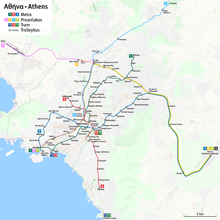
Athens is the major transportation hub of Greece. The city has the largest airport in Greece and the largest port in Greece, which is also the largest port in Mediterranean in containers transport and the largest passenger port in Europe. It is also a major national hub for Intercity (Ktel) and international buses as well as for domestic and international rail transport. Public transport is serviced by a variety of transportation means, forming the largest mass transit system of Greece. The Athens Mass Transit System consists of a large bus and trolleybus fleet, the city's Metro, a commuter rail service[118] and a tram network, connecting the southern suburbs to the city centre.[119]
Bus transport[]
OSY (Greek: ΟΣΥ) (Odikes Sygkoinonies S.A.), a subsidiary company of OASA (Athens urban transport organisation), is the main operator of buses and trolleybuses in Athens. As of 2017, its network consists of about 322 bus lines which span the Athens Metropolitan Area, with a fleet of 2,375 buses buses and trolleybuses. Of those 2,375 buses 619 run on compressed natural gas, making up the largest fleet of natural gas-powered buses in Europe, and 354 are electric buses (trolleybuses). All of the 354 trolleybuses are equipped to enable them to run on diesel in case of power failure.[120]
International links are provided by a number of private companies. National and regional bus links are provided by KTEL from two InterCity Bus Terminals, Kifissos Bus Terminal A and Liosion Bus Terminal B, both located in the north-western part of the city. Kifissos provides connections towards Peloponnese, North Greece, West Greece and some Ionian Islands, whereas Liosion is used for most of Central Greece.
Athens Metro[]
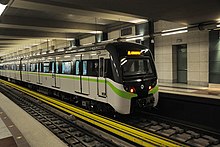
The Athens Metro is operated by STASY S.A (Greek: ΣΤΑΣΥ) (Statheres Sygkoinonies S.A) which is a subsidiary company of OASA (Athens urban transport organisation) and provides public transport throughout the Athens Urban Area. While its main purpose is transport, it also houses Greek artifacts found during construction of the system.[121] The Athens Metro runs three metro lines, namely Line 1 (Green Line), Line 2 (Red Line) and Line 3 (Blue Line) lines, of which the first was constructed in 1869, and the other two largely during the 1990s, with the initial new sections opened in January 2000. Line 1 mostly runs at ground level and the other two (Line 2 & 3) routes run entirely underground. A fleet of 42 trains, using 252 carriages, operates on the network,[122] with a daily occupancy of 1,353,000 passengers.[123]
Line 1 (Green Line) serves 24 stations, and is the oldest line of the Athens metro network. It runs from Piraeus station to Kifissia station and covers a distance of 25.6 km (15.9 mi). There are transfer connections with the Blue Line 3 at Monastiraki station and with the Red Line 2 at Omonia and Attiki stations.
Line 2 (Red Line) runs from Anthoupoli station to Elliniko station and covers a distance of 17.5 km (10.9 mi).[122] The line connects the western suburbs of Athens with the southeast suburbs, passing through the center of Athens. The Red Line has transfer connections with the Green Line 1 at Attiki and Omonia stations. There are also transfer connections with the Blue Line 3 at Syntagma station and with the tram at Syntagma, Syngrou Fix and Neos Kosmos stations.
Line 3 (Blue Line) runs from Nikaia station, through the central Monastiraki and Syntagma stations to Doukissis Plakentias avenue in the northeastern suburb of Halandri.[122] It then ascends to ground level and continues to Athens International Airport Eleftherios Venizelos using the suburban railway infrastructure, extending its total length to 39 km (24 mi).[122] The spring 2007 extension from Monastiraki westwards to Egaleo connected some of the main night life hubs of the city, namely those of Gazi (Kerameikos station) with Psirri (Monastiraki station) and the city centre (Syntagma station). Extensions are under construction to the western and southwestern suburbs of Athens, as far as the Port of Piraeus. The new stations will be Maniatika, Piraeus and Dimotiko Theatro, and the completed extension will be ready in 2022, connecting the biggest port of Greece, the Port of Piraeus, with Athens International Airport, the biggest airport of Greece.
Commuter/suburban rail (Proastiakos)[]

The Athens commuter rail service, referred to as the "Proastiakós", connects Athens International Airport to the city of Kiato, 106 km (66 mi)[124] west of Athens, via Larissa station, the city's central rail station and the port of Piraeus. The length of Athens's commuter rail network extends to 120 km (75 mi),[124] and is expected to stretch to 281 km (175 mi) by 2010.[124]
Tram[]

Athens Tram is operated by STASY S.A (Statheres Sygkoinonies S.A) which is a subsidiary company of OASA (Athens urban transport organisation). It has a fleet of 35 Sirio type vehicles[125] which serve 48 stations,[125] employ 345 people with an average daily occupancy of 65,000 passengers.[125] The tram network spans a total length of 27 km (17 mi) and covers ten Athenian suburbs.[125] The network runs from Syntagma Square to the southwestern suburb of Palaio Faliro, where the line splits in two branches; the first runs along the Athens coastline toward the southern suburb of Voula, while the other heads toward Neo Faliro. The network covers the majority of the Athens coastline.[126] Further extension is under construction towards the major commercial port of Piraeus.[125] The expansion to Piraeus will include 12 new stations, increase the overall length of tram route by 5.4 km (3 mi), and increase the overall transportation network.[127]
Athens International Airport[]

Athens is served by the Athens International Airport (ATH), located near the town of Spata, in the eastern Messoghia plain, some 35 km (22 mi) east of center of Athens.[128] The airport, awarded the "European Airport of the Year 2004" Award,[129] is intended as an expandable hub for air travel in southeastern Europe and was constructed in 51 months, costing 2.2 billion euros. It employs a staff of 14,000.[129]
The airport is served by the Metro, the suburban rail, buses to Piraeus port, Athens' City Centre, Liosion and Kifisos Intercity bus stations and Elliniko metro's line 2 southern terminal, and also taxis. The airport accommodates 65 landings and take-offs per hour,[128] with its 24-passenger boarding bridges,[128] 144 check-in counters and broader 150,000 m2 (1,614,587 sq ft) main terminal;[128] and a commercial area of 7,000 m2 (75,347 sq ft) which includes cafés, duty-free shops,[129] and a small museum.
In 2018, the airport handled 24,135,736 passengers, a huge increase over the last 4 years. In 2014, the airport handled 15,196,369 passengers, an increase of 21.2% over the previous year of 2013.[130] Of those 15,196,369 passengers, 5,267,593 passed through the airport for domestic flights,[131] and 9,970,006 passengers travelled through for international flights.[131] Beyond the dimensions of its passenger capacity, ATH handled 205,294 total flights in 2007, or approximately 562 flights per day.[132]
Railways and ferry connections[]
Athens is the hub of the country's national railway system (OSE), connecting the capital with major cities across Greece and abroad (Istanbul, Sofia, Belgrade and Bucharest). The Port of Piraeus is the largest port in Greece and one of the largest in Europe. It is the largest container port in East Mediterranean Sea Basin. It is also the busiest passenger port in Europe and one of the largest passenger ports in the world. It connects Athens to the numerous Greek islands of the Aegean Sea, with ferries departing, while also serving the cruise ships that arrive.[133][134][135] Rafina and Lavrio act as alternative ports of Athens, connects the city with numerous Greek islands of the Aegean Sea, Evia and Cesme in Turkey,[136][137] while also serving the cruise ships that arrive.
Motorways[]
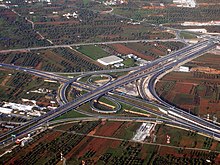

Two main motorways of Greece begin in Athens, namely the A1/E75, heading north towards Greece's second largest city, Thessaloniki; and the border crossing of Evzones and the A8/E94 heading west, towards Greece's third largest city, Patras, which incorporated the GR-8A. Before their completion much of the road traffic used the GR-1 and the GR-8.
Athens' Metropolitan Area is served by the motorway network of the Attiki Odos toll-motorway (code: A6). Its main section extends from the western industrial suburb of Elefsina to Athens International Airport; while two beltways, namely the Aigaleo Beltway (A65) and the Hymettus Beltway (A64) serve parts of western and eastern Athens respectively. The span of the Attiki Odos in all its length is 65 km (40 mi),[138] making it the largest metropolitan motorway network in all of Greece.
- Motorways:
- National roads:
- GR-1 Ν (Lamia, Larissa, Thessaloniki)
- GR-8 W (Corinth, Patras)
- GR-3 N (Elefsina, Lamia, Larissa)
Education[]
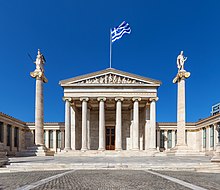
Located on Panepistimiou Street, the old campus of the University of Athens, the National Library, and the Athens Academy form the "Athens Trilogy" built in the mid-19th century. The largest and oldest university in Athens is the National and Kapodistrian University of Athens. Most of the functions of NKUA have been transferred to a campus in the eastern suburb of Zografou. The National Technical University of Athens is located on Patision Street. In this area, on November 17, 1973, more than 13 students were killed and hundreds injured during the Athens Polytechnic uprising[139] against the military junta that ruled the nation from 21 April 1967 until 23 July 1974.

The University of West Attica is the second largest university in Athens. The seat of the university is located in the Western Sector of Athens where Ancient Athenian Philosophers gave academic lectures. All the activities of UNIWA are carried out in the modern infrastructure of the three University Campuses within the metropolitan region of Athens (Egaleo Park, Ancient Olive Groove and Athens), which offer modern teaching and research spaces, entertainment and support facilities for all students. Other universities that lie within Athens are the Athens University of Economics and Business, the Panteion University, the Agricultural University of Athens and the University of Piraeus. There are overall ten state-supported Institutions of Higher (or Tertiary) education located in the Athens Urban Area, these are by chronological order: Athens School of Fine Arts (1837), National Technical University of Athens (1837), National and Kapodistrian University of Athens (1837), Agricultural University of Athens (1920), Athens University of Economics and Business (1920), Panteion University of Social and Political Sciences (1927), University of Piraeus (1938), Harokopio University of Athens (1990), School of Pedagogical and Technological Education (2002), University of West Attica (2018). There are also several other private colleges, as they called formally in Greece, as the establishment of private universities is prohibited by the constitution. Many of them are accredited by a foreign state or university such as the American College of Greece and the Athens Campus of the University of Indianapolis.[140]
Culture[]
Archaeological hub[]
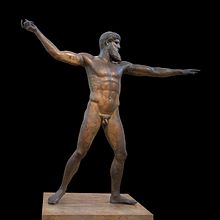
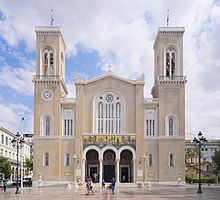

The city is a world centre of archaeological research. Along with national institutions, such as the Athens University and the Archaeological Society, there are multiple archaeological Museums including the National Archaeological Museum, the Cycladic Museum, the Epigraphic Museum, the Byzantine & Christian Museum, as well as museums at the ancient Agora, Acropolis, Kerameikos, and the Kerameikos Archaeological Museum. The city is also home to the Demokritos laboratory for Archaeometry, alongside regional and national archaeological authorities that form part of the Greek Department of Culture.

Athens hosts 17 Foreign Archaeological Institutes which promote and facilitate research by scholars from their home countries. As a result, Athens has more than a dozen archaeological libraries and three specialized archaeological laboratories, and is the venue of several hundred specialized lectures, conferences and seminars, as well as dozens of archaeological exhibitions, each year. At any given time, hundreds of international scholars and researchers in all disciplines of archaeology are to be found in the city.
Architecture[]
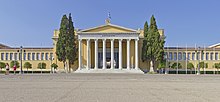

Athens incorporates architectural styles ranging from Greco-Roman and Neoclassical to modern times. They are often to be found in the same areas, as Athens is not marked by a uniformity of architectural style. A visitor will quickly notice the absence of tall buildings: Athens has very strict height restriction laws in order to ensure the Acropolis hill is visible throughout the city. Despite the variety in styles, there is evidence of continuity in elements of the architectural environment through the city's history.[21]
For the greatest part of the 19th century Neoclassicism dominated Athens, as well as some deviations from it such as Eclecticism, especially in the early 20th century. Thus, the Old Royal Palace was the first important public building to be built, between 1836 and 1843. Later in the mid and late 19th century, Theophil Freiherr von Hansen and Ernst Ziller took part in the construction of many neoclassical buildings such as the Athens Academy and the Zappeion Hall. Ziller also designed many private mansions in the centre of Athens which gradually became public, usually through donations, such as Schliemann's Iliou Melathron.
Beginning in the 1920s, modern architecture including Bauhaus and Art Deco began to exert an influence on almost all Greek architects, and buildings both public and private were constructed in accordance with these styles. Localities with a great number of such buildings include Kolonaki, and some areas of the centre of the city; neighbourhoods developed in this period include Kypseli.[142]
In the 1950s and 1960s during the extension and development of Athens, other modern movements such as the International style played an important role. The centre of Athens was largely rebuilt, leading to the demolition of a number of neoclassical buildings. The architects of this era employed materials such as glass, marble and aluminium, and many blended modern and classical elements.[143] After World War II, internationally known architects to have designed and built in the city included Walter Gropius, with his design for the US Embassy, and, among others, Eero Saarinen, in his postwar design for the east terminal of the Ellinikon Airport.
Urban sculpture[]

All over the city can be found several statues or busts. Apart from the neoclassicals by Leonidas Drosis at the Academy of Athens (Plato, Socrates, Apollo, Athena), other notable include the statue of Theseus by at Thiseion, of philhellenes like Lord Byron, George Canning and William Gladstone, the equestrian statue of Theodoros Kolokotronis by Lazaros Sochos in front of the Old Parliament, statues of Ioannis Kapodistrias, Rigas Feraios and Adamantios Korais at the university, of Evangelos Zappas and Konstantinos Zappas at Zappeion, of Ioannis Varvakis at the National Garden, the "woodbreaker" by , the equestrian statue of Alexandros Papagos at Papagou district and various busts of fighters of Greek independence at the Pedion tou Areos. A significant landmark is also the Tomb of the Unknown Soldier in Syntagma.
Museums[]


Athens' most important museums include:
- the National Archaeological Museum, the largest archaeological museum in the country, and one of the most important internationally, as it contains a vast collection of antiquities; its artifacts cover a period of more than 5,000 years, from late Neolithic Age to Roman Greece;
- the Benaki Museum with its several branches for each of its collections including ancient, Byzantine, Ottoman-era, and Chinese art and beyond;
- the Byzantine and Christian Museum, one of the most important museums of Byzantine art;
- the National Art Gallery, the most important art gallery in Greece which reopened in 2021 after renovations;
- the National Museum of Contemporary Art, which opened in 2000 in a former brewery building;
- the Numismatic Museum, housing a major collection of ancient and modern coins;
- the Museum of Cycladic Art, home to an extensive collection of Cycladic art, including its famous figurines of white marble;
- the New Acropolis Museum, opened in 2009, and replacing the old museum on the Acropolis. The new museum has proved considerably popular; almost one million people visited during the summer period June–October 2009 alone. A number of smaller and privately owned museums focused on Greek culture and arts are also to be found.
- the Kerameikos Archaeological Museum, a museum which displays artifacts from the burial site of Kerameikos. Much of the pottery and other artifacts relate to Athenian attitudes towards death and the afterlife, throughout many ages.
- the Jewish Museum of Greece, a museum which describes the history and culture of the Greek Jewish community.
Tourism[]
Athens has been a destination for travellers since antiquity. Over the past decade, the city's infrastructure and social amenities have improved, in part because of its successful bid to stage the 2004 Olympic Games. The Greek Government, aided by the EU, has funded major infrastructure projects such as the state-of-the-art Eleftherios Venizelos International Airport,[144] the expansion of the Athens Metro system,[78] and the new Attiki Odos Motorway.[78]
Athens was voted as the third best European city to visit in 2015 by European Best Destination. More than 240,000 people voted.
Entertainment and performing arts[]
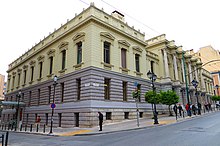
Athens is home to 148 theatrical stages, more than any other city in the world, including the ancient Odeon of Herodes Atticus, home to the Athens Festival, which runs from May to October each year.[145][146] In addition to a large number of multiplexes, Athens plays host to open air garden cinemas. The city also supports music venues, including the Athens Concert Hall (Megaro Moussikis), which attracts world class artists.[147] The Athens Planetarium,[148] located in Andrea Syngrou Avenue, in Palaio Faliro[149] is one of the largest and best equipped digital planetaria in the world.[150] The Stavros Niarchos Foundation Cultural Center, inaugurated in 2016, will house the National Library of Greece and the Greek National Opera.[151]
Restaurants, tavernas and bars can be found in the entertainment hubs in Plaka and the Trigono areas of the historic centre, the inner suburbs of Gazi and Psyrri are especially busy with nightclubs and bars, while Kolonaki, Exarchia, Metaxourgeio, Koukaki and Pangrati have more of a cafe and restaurant scene. The coastal suburbs of Microlimano, Alimos and Glyfada have tavernas, beach bars and busy summer clubs.
Music

The most successful songs during the period 1870–1930 were the so-called Athenian serenades (Αθηναϊκές καντάδες), based on the Heptanesean kantádhes (καντάδες 'serenades'; sing.: καντάδα) and the songs performed on stage (επιθεωρησιακά τραγούδια 'theatrical revue songs') in revues, musical comedies, operettas and nocturnes that were dominating Athens' theatre scene.
Notable composers of operettas or nocturnes were Kostas Giannidis, , , while Theophrastos Sakellaridis' The Godson remains probably the most popular operetta. Despite the fact that the Athenian songs were not autonomous artistic creations (in contrast with the serenades) and despite their original connection with mainly dramatic forms of Art, they eventually became hits as independent songs. Notable actors of Greek operettas, who made also a series of melodies and songs popular at that time, include Orestis Makris, , Vasilis Avlonitis, Afroditi Laoutari, Eleni Papadaki, Marika Nezer, Marika Krevata and others. After 1930, wavering among American and European musical influences as well as the Greek musical tradition. Greek composers begin to write music using the tunes of the tango, waltz, swing, foxtrot, some times combined with melodies in the style of Athenian serenades' repertory. Nikos Gounaris was probably the most renowned composer and singer of the time.
In 1922, after the genocide of the Greek people of Minor Asia and Pontus and later by the population exchange between Greece and Turkey, many ethnic Greeks from Asia Minor and Pontus fled to Athens as a result of the Greco-Turkish War. They settled in poor neighborhoods and brought with them Rebetiko music, making it popular also in Greece, which became later the base for the Laïko music. Other forms of song popular today in Greece are elafrolaika, entechno, dimotika, and skyladika.[152] Greece's most notable, and internationally famous, composers of Greek song, mainly of the entechno form, are Manos Hadjidakis and Mikis Theodorakis. Both composers have achieved fame abroad for their composition of film scores.[152]
Sports[]
Overview[]
Athens has a long tradition in sports and sporting events, serving as home to the most important clubs in Greek sport and housing a large number of sports facilities. The city has also been host to sports events of international importance.
Athens has hosted the Summer Olympic Games twice, in 1896 and 2004. The 2004 Summer Olympics required the development of the Athens Olympic Stadium, which has since gained a reputation as one of the most beautiful stadiums in the world, and one of its most interesting modern monuments.[153] The biggest stadium in the country, it hosted two finals of the UEFA Champions League, in 1994 and 2007. Athens' other major stadium, located in the Piraeus area, is the Karaiskakis Stadium, a sports and entertainment complex, host of the 1971 UEFA Cup Winners' Cup Final.
Athens has hosted the EuroLeague final three times, the first in 1985 and second in 1993, both at the Peace and Friendship Stadium, most known as SEF, a large indoor arena,[154] and the third time in 2007 at the Olympic Indoor Hall. Events in other sports such as athletics, volleyball, water polo etc., have been hosted in the capital's venues.
Athens is home to three European multi-sport clubs: Panathinaikos, originated in Athens city centre, Olympiacos, originated in the suburb of Piraeus and AEK Athens, originated in the suburb of Nea Filadelfeia. In football, Panathinaikos made it to the 1971 European Cup Final, Olympiacos have dominated domestic competitions, while AEK Athens is the other member of the big three. These clubs also have basketball teams; Panathinaikos and Olympiacos are among the top powers in European basketball, having won the Euroleague six times and three respectively, whilst AEK Athens was the first Greek team to win a European trophy in any team sport.
Other notable clubs within Athens are Athinaikos, Panionios, Atromitos, Apollon, Panellinios, Egaleo F.C., Ethnikos Piraeus, Maroussi BCE and Peristeri B.C.. Athenian clubs have also had domestic and international success in other sports.
The Athens area encompasses a variety of terrain, notably hills and mountains rising around the city, and the capital is the only major city in Europe to be bisected by a mountain range. Four mountain ranges extend into city boundaries and thousands of kilometres of trails criss-cross the city and neighbouring areas, providing exercise and wilderness access on foot and bike.
Beyond Athens and across the prefecture of Attica, outdoor activities include skiing, rock climbing, hang gliding and windsurfing. Numerous outdoor clubs serve these sports, including the Athens Chapter of the Sierra Club, which leads over 4,000 outings annually in the area.
Sports clubs[]
| Notable sport clubs based inside the boundaries of Athens Municipality | ||||
|---|---|---|---|---|
| Club | Founded | Sports | District | Achievements |
| Panellinios G.S. | 1891 | Basketball, Volleyball, Handball, Track and Field and others | Kypseli | Panhellenic titles in Basketball, Volleyball, Handball, many honours in Track and Field |
| Apollon Smyrni | 1891 (originally in Smyrni) |
Football, Basketball, Volleyball and others | Rizoupoli | Earlier long-time presence in A Ethniki |
| Ethnikos G.S. Athens | 1893 | Track and field, Wrestling, Shooting and others | Zappeion | Many honours in Athletics and Wrestling |
| Panathinaikos AO | 1908 (originally as Football Club of Athens) |
Football, Basketball, Volleyball, Water Polo, Track and Field and others | Ampelokipoi | One of the most successful Greek clubs, many titles in many sports. Most successful Greek club in European competitions (football and basketball) |
| Ilisiakos | 1927 | Football, Basketball | Ilisia | Earlier presence in A1 Ethniki basketball |
| Asteras Exarchion | 1928 (originally as Achilleus Neapoleos) | Football, Basketball | Exarcheia | Earlier presence in A1 Ethniki women basketball |
| Ampelokipoi B.C. | 1929 (originally as Hephaestus Athens) | Basketball | Ampelokipoi | Earlier presence in A1 Ethniki basketball |
| Thriamvos Athens | 1930 (originally as Doxa Athens) | Football, Basketball | Neos Kosmos | Panhellenic title in women Basketball |
| Sporting B.C. | 1936 | Basketball | Patisia | Many Panhellenic titles in women Basketball |
| Pagrati B.C. | 1938 | Basketball | Pagrati | Earlier presence in A1 Ethniki |
Beside the above clubs, inside the boundaries of Athens Municipality there are some more clubs with presence in national divisions or notable action for short periods. Some of them are PAO Rouf (Rouf) with earlier presence in Gamma Ethniki, (el) (Petralona), football club founded in 1963, with earlier presence in Beta Ethniki, (el) (Kolonos), football club founded in 1919 with short presence in Gamma Ethniki, (Kypseli), football club founded in 1938 with short presence in Gamma Ethniki, (Gyzi), basketball club founded in 1937 with short presence in Beta Ethniki basketball and (el) (Agios Panteleimonas), basketball club founded in 1992 with earlier presence in A2 Ethniki Basketball. Another important Athenian sport club is the Athens Tennis Club founded in 1895 with important offer for the Greek tennis.[155]
Olympic Games[]
1896 Summer Olympics[]
The revival of the modern Olympic Games was brought forth in 1896, by Frenchman Pierre de Coubertin. Thanks to his efforts, Athens was awarded the first modern Olympic Games. In 1896, the city had a population of 123,000[95] and the event helped boost the city's international profile. Of the venues used for these Olympics, the Kallimarmaro Stadium, and Zappeion were most crucial. The Kallimarmaro is a replica of the ancient Athenian stadiums, and the only major stadium (in its capacity of 60,000) to be made entirely of white marble from Mount Penteli, the same material used for construction of the Parthenon.

Fencing before the king of Greece at the 1896 Summer Olympics.
The Panathenaic Stadium of Athens (Kallimarmaron) dates back to the 4th century BC and has hosted the first modern Olympic Games in 1896.
1906 Summer Olympics[]
The 1906 Summer Olympics, or the 1906 Intercalated games, were held in Athens. The intercalated competitions were intermediate games to the internationally organized Olympics, and were meant to be organized in Greece every four years, between the main Olympics. This idea later lost support from the IOC and these games were discontinued.
2004 Summer Olympics[]

Athens was awarded the 2004 Summer Olympics on 5 September 1997 in Lausanne, Switzerland, after having lost a previous bid to host the 1996 Summer Olympics, to Atlanta, United States.[22] It was to be the second time Athens would host the games, following the inaugural event of 1896. After an unsuccessful bid in 1990, the 1997 bid was radically improved, including an appeal to Greece's Olympic history. In the last round of voting, Athens defeated Rome with 66 votes to 41.[22] Prior to this round, the cities of Buenos Aires, Stockholm and Cape Town had been eliminated from competition, having received fewer votes.[22]
During the first three years of preparations, the International Olympic Committee had expressed concern over the speed of construction progress for some of the new Olympic venues. In 2000 the Organising Committee's president was replaced by Gianna Angelopoulos-Daskalaki, who was the president of the original Bidding Committee in 1997. From that point forward, preparations continued at a highly accelerated, almost frenzied pace.
Although the heavy cost was criticized, estimated at $1.5 billion, Athens was transformed into a more functional city that enjoys modern technology both in transportation and in modern urban development.[156] Some of the finest sporting venues in the world were created in the city, all of which were fully ready for the games. The games welcomed over 10,000 athletes from all 202 countries.[156]
The 2004 Games were judged a success, as both security and organization worked well, and only a few visitors reported minor problems mainly concerning accommodation issues. The 2004 Olympic Games were described as Unforgettable, dream Games, by IOC President Jacques Rogge for their return to the birthplace of the Olympics, and for meeting the challenges of holding the Olympic Games.[156] The only observable problem was a somewhat sparse attendance of some early events. Eventually, however, a total of more than 3.5 million tickets were sold, which was higher than any other Olympics with the exception of Sydney (more than 5 million tickets were sold there in 2000).[157]
In 2008 it was reported that most of the Olympic venues had fallen into disrepair: according to those reports, 21 of the 22 facilities built for the games had either been left abandoned or are in a state of dereliction, with several squatter camps having sprung up around certain facilities, and a number of venues afflicted by vandalism, graffiti or strewn with rubbish.[158][159] These claims, however, are disputed and likely to be inaccurate, as most of the facilities used for the Athens Olympics are either in use or in the process of being converted for post-Olympics use. The Greek Government has created a corporation, Olympic Properties SA, which is overseeing the post-Olympics management, development and conversion of these facilities, some of which will be sold off (or have already been sold off) to the private sector,[160] while other facilities are still in use just as during the Olympics, or have been converted for commercial use or modified for other sports.[161] Concerts and theatrical shows, such as those by the troupe Cirque du Soleil, have recently been held in the complex.[152]
See also[]
- Outline of Athens
- Athens of the North (disambiguation)
References[]
- ^ "Eurostat – Data Explorer". appsso.eurostat.ec.europa.eu. Archived from the original on 3 December 2018. Retrieved 23 November 2017.
- ^ Jump up to: a b c d e f Απογραφή Πληθυσμού – Κατοικιών 2011. ΜΟΝΙΜΟΣ Πληθυσμός (in Greek). Hellenic Statistical Authority. Archived from the original on 18 April 2016. Retrieved 29 March 2017.
- ^ "Regions and Cities at a Glance 2018 – Greece" (PDF). OECD. Archived (PDF) from the original on 5 February 2021. Retrieved 5 November 2020.
- ^ Wells, John C. (1990). "Athens". Longman pronunciation dictionary. Harlow, England: Longman. p. 48. ISBN 0-582-05383-8.
- ^ Vinie Daily, Athens, the city in your pocket, pp 6
- ^ Jump up to: a b "v4.ethnos.gr – Οι πρώτοι… Αθηναίοι". Ethnos.gr. July 2011. Archived from the original on 21 July 2011. Retrieved 26 October 2018.
- ^ "Contents and Principles of the Programme of Unification of the Archaeological Sites of Athens". Hellenic Ministry of Culture. yppo.gr. Archived from the original on 21 August 2016. Retrieved 31 December 2009.
- ^ CNN & Associated Press (16 January 1997). "Greece uncovers 'holy grail' of Greek archeology". CNN. Archived from the original on 6 December 2007. Retrieved 28 March 2007.
- ^ "Athens". Archived from the original on 6 January 2009. Retrieved 31 December 2008.
Ancient Greek Athenai, historic city and capital of Greece. Many of classical civilization's intellectual and artistic ideas originated there, and the city is generally considered to be the birthplace of Western civilization
- ^ BBC History on Greek Democracy Archived 19 December 2019 at the Wayback Machine – Accessed on 26 January 2007
- ^ Encarta Ancient Greece from the Internet Archive– Retrieved on 28 February 2012. Archived 31 October 2009.
- ^ "The World According to GaWC 2020". GaWC – Research Network. Globalization and World Cities. Archived from the original on 24 August 2020. Retrieved 31 August 2020.
- ^ "Port of the month: Piraeus Port Authority". European Sea Ports Organisation V.Z.W./A.S.B.L. (ESPO). 30 April 2014. Archived from the original on 13 July 2015. Retrieved 4 May 2015.
The Port of Piraeus is a port of large sizes. It is the largest passenger port and one of the largest commercial ports in Europe.
- ^ Qihao Weng (23 May 2014). Global Urban Monitoring and Assessment through Earth Observation. CRC Press. p. 259. ISBN 978-1-4665-6450-3. Archived from the original on 27 October 2015. Retrieved 19 October 2015.
Piraeus port, the chief port in Greece and the largest passenger port in Europe,
- ^ "ANEK Lines – Piraeus". ANEK Lines. Archived from the original on 3 December 2008. Retrieved 27 December 2008.
- ^ Jump up to: a b "Population & housing census 2001 (incl. area and average elevation)" (PDF) (in Greek). National Statistical Service of Greece. Archived from the original (PDF) on 21 September 2015.
- ^ Jump up to: a b c d "Characteristics". Hellenic Interior Ministry. ypes.gr. Archived from the original on 4 January 2007. Retrieved 6 January 2007.
- ^ Monthly Statistical Bulletin of Greece, December 2012. ELSTAT. 2012. p. 64.
- ^ Jump up to: a b c d "ΕΛΣΤΑΤ Απογραφη 2011" (PDF). statistics.gr. Archived from the original (PDF) on 11 October 2011. Retrieved 22 August 2011.
- ^ Jump up to: a b "Archived copy". Archived from the original on 3 September 2015. Retrieved 13 October 2016.CS1 maint: archived copy as title (link)
- ^ Jump up to: a b c Skartsēs, Lampros (2020). Exploring Continuity in Secular and Domestic Architecture of Athens Through 5000 Years of History (Open Access eBook). ISBN 978-960-571-383-6. Archived from the original on 29 May 2021. Retrieved 8 September 2020.
- ^ Jump up to: a b c d CNN & Sports Illustrated (5 September 1997). "Sentiment a factor as Athens gets 2004 Olympics". sportsillustrated.cnn.com. Archived from the original on 19 May 2008. Retrieved 28 March 2007.
- ^ As for example in Od.7.80 Archived 18 April 2021 at the Wayback Machine.
- ^ Jump up to: a b Beekes, Robert S. P. (2009), Etymological Dictionary of Greek, Leiden and Boston: Brill, p. 29
- ^ Jump up to: a b c Burkert, Walter (1985), Greek Religion, Cambridge, Massachusetts: Harvard University Press, p. 139, ISBN 0-674-36281-0
- ^ Jump up to: a b c d e f g h Kerényi, Karl (1951), The Gods of the Greeks, London, England: Thames and Hudson, p. 124, ISBN 0-500-27048-1
- ^ Jump up to: a b Garland, Robert (2008). Ancient Greece: Everyday Life in the Birthplace of Western Civilization. New York: Sterling. ISBN 978-1-4549-0908-8.
- ^ Great Greek Encyclopedia, vol. II, Athens 1927, p. 30.
- ^ "ToposText". topostext.org. Archived from the original on 25 February 2021. Retrieved 27 March 2020.
- ^ Bourne, Edward G. (1887). "The Derivation of Stamboul". American Journal of Philology. The Johns Hopkins University Press. 8 (1): 78–82. doi:10.2307/287478. JSTOR 287478.
- ^ 'General Storia' (Global History)
- ^ Osmanlı Yer Adları, Ankara 2017, s.v. full text Archived 31 July 2020 at the Wayback Machine
- ^ S. Immerwahr, The Athenian Agora XIII: the Neolithic and Bronze Ages, Princeton 1971
- ^ Jump up to: a b c d Tung, Anthony (2001). "The City the Gods Besieged". Preserving the World's Great Cities: The Destruction and Renewal of the Historic Metropolis. New York: Three Rivers Press. p. 266. ISBN 0-609-80815-X.
- ^ Iakovides, S. 1962. 'E mykenaïke akropolis ton Athenon'. Athens.
- ^ Osborne, R. 1996, 2009. Greece in the Making 1200–479 BC.
- ^ Lewis, John David (25 January 2010). Nothing Less than Victory: Decisive Wars and the Lessons of History. ISBN 978-1400834303. Archived from the original on 12 March 2020. Retrieved 24 December 2014.
- ^ "Focus on Athens" (PDF). UHI Quarterly Newsletter, Issue 1, May 2009, page 2. urbanheatisland.info. Archived from the original (PDF) on 22 July 2013. Retrieved 18 March 2011.
- ^ "Welcome!!!". Parnitha-np.gr. Archived from the original on 28 January 2019. Retrieved 10 June 2009.
- ^ "Acropolis: Threat of Destruction". Time. 31 January 1977. Archived from the original on 30 September 2007. Retrieved 3 April 2007.
- ^ Jump up to: a b c d Kitsantonis, Niki (16 July 2007). "As forest fires burn, suffocated Athens is outraged". International Herald Tribune. Archived from the original on 18 September 2007. Retrieved 3 February 2008.
- ^ Συνέντευξη Τύπου Γ. Σουφλιά για την Πάρνηθα (Press release) (in Greek). Hellenic Ministry for the Environment, Physical Planning, & Public Works. 18 July 2007. Archived from the original (.doc) on 16 February 2008. Retrieved 15 January 2008.
Συνολική καμένη έκταση πυρήνα Εθνικού Δρυμού Πάρνηθας: 15.723 (Σύνολο 38.000)
- ^ Jump up to: a b "Rot sets in as Athens's trash problem mounts". 30 January 2007. Archived from the original on 14 January 2009. Retrieved 10 February 2008.
- ^ "SAFE CITIES INDEX 2017: Security in a rapidly urbanizing world" (PDF). The Economist Intelligent Unit. 9 December 2017. Archived (PDF) from the original on 16 October 2017. Retrieved 8 February 2018.
- ^ "Athens SAFETY INDEX". Safe Around. Archived from the original on 29 October 2019. Retrieved 1 September 2019.
- ^ "Is Athens Safe? Areas to Avoid and Other Warnings". Mercer. 26 February 2019. Archived from the original on 16 July 2019. Retrieved 8 February 2019.
- ^ "Worldwide Quality of Living ranking 2019". Mercer. 13 March 2019. Archived from the original on 19 March 2019. Retrieved 8 February 2018.
- ^ "Founda D. (2011). "Evolution of the air temperature in Athens and evidence of climatic change: A review". Advances in Building Energy Research, 5,1, 7–41". Archived from the original on 5 August 2011. Retrieved 3 July 2011.
- ^ "Climate Atlas of Greece" (PDF). Hellenic National Meteorological Service. Archived from the original (PDF) on 21 September 2017. Retrieved 30 December 2019.
- ^ Το αρχείο του Θησείου (in Greek). Meteoclub. Archived from the original on 4 May 2016. Retrieved 5 August 2019.
- ^ Κωνσταντίνος Μαυρογιάννης, Αθήναι (1981).Παρατηρήσεις επί του κλίματος των Αθηνών και της ενεργείας αυτού επί της ζωϊκής οικονομίας σελ 29.
- ^ hpanitsidis (22 June 2007). "Εργο Αναβαθμισης Διυλιστηριου Ελευσινας" (PDF). Archived (PDF) from the original on 20 December 2014. Retrieved 3 October 2014.
- ^ Giannopoulou K., Livada I., Santamouris M., Saliari M., Assimakopoulos M., Caouris Y.G. (2011). "On the characteristics of the summer urban heat island in Athens, Greece". Sustainable Cities and Society, 1, pp. 16–28.
- ^ Giannakopoulos C., Hatzai M., Kostopoulou E., McCarty M., Goodess C. (2010). "The impact of climate change and urban heat islands on the occurrence of extreme events in cities. The Athens case". Proc. of the 10th International Conference on Meteorology, Climatology and Atmospheric Physics, Patras, Greece, 25–28 May 2010, pp. 745–752.
- ^ Jump up to: a b "European Space Agency ESA helps make summer in the city more bearable". Archived from the original on 22 November 2010. Retrieved 7 November 2010.
- ^ Jump up to: a b Katsoulis B.D., Theoharatos G.A. (1985). "Indications of the Urban Heat Island in Athens, Greece". Journal of Applied Meteorology, vol. 24, Issue 12, pp.1296–1302
- ^ Stathopoulou M., Cartalis C., Andritsos A. (2005)."Assessing the thermal environment of major cities in Greece". International Conference "Passive and Low Energy Cooling for the Built Environment", May 2005, Santorini, Greece, pp. 108–112.
- ^ Kassomenos P.A. and Katsoulis B.D. (2006). "Mesoscale and macroscale aspects of the morning Urban Heat Island around Athens, Greece", Meteorology and Atmospheric Physics, 94, pp. 209–218.
- ^ Santamouris M., Papanikolaou N., Livada I., Koronakis I., Georgakis A., Assimakopoulos D.N. (2001). "On the impact of urban climate on the energy consumption of buildings". Solar Energy, 70 (3): pp. 201–216.
- ^ Santamouris M. (1997). "Passive Cooling and Urban Layout". Interim Report, POLIS Research Project, European Commission, Directorate General for Science, Research and Development and human wellbeing and health.
- ^ Santamouris M., Papanikolaou I., Livada I., Koronakis C., Georgakis C, Assimakopoulos D.N. (2001). "On the impact of Urban Climate to the Energy Consumption of Buildings". Solar Energy, 70, 3, pp. 201–216.
- ^ Katsoulis, B. (1987). "Indications of change of climate from the Analysis of air temperature time series in Athens, Greece". Climatic Change. 10 (1): 67–79. Bibcode:1987ClCh...10...67K. doi:10.1007/BF00140557. S2CID 153998695.
- ^ Repapis, C. C.; Metaxas, D. A. (1985). "The Possible influence of the urbanization in Athens city on the air temperature climatic fluctuations at the National Observatory". Proc. Of the 3rd Hellenic-British Climatological Congress, Athens, Greece 17–21 April 1985: 188–195.
- ^ Philandras, C. M.; Metaxas, D. A.; Nastos, P. T. (1999). "Climate variability and Urbanization in Athens". Theoretical and Applied Climatology. 63 (1–2): 65–72. Bibcode:1999ThApC..63...65P. doi:10.1007/s007040050092. S2CID 53485072.
- ^ Philandras, C. M.; Nastos, P. T. (2002). "The Athens urban effect on the air temperature time series of the National Observatory of Athens and New Philadelphia stations". Proc. Of the 6th Hellenic Conference on Meteorology, Climatology and Atmospheric Physics, Ioannina Greece, 25–28 September 2002: 501–506.
- ^ Repapis, C. C.; Philandras, C. M.; Kalabokas, P. D.; Zerefos, C. S. (2007). "Is the last years abrupt warming in the National Observatory of Athens records a Climate Change Manifestation?". Global NEST Journal. 9 (2): 107–116.
- ^ Livada, I.; Santamouris, M.; Niachou, K.; Papanikolaou, N.; Mihalakakou, G. (2002). "Determination of places in the great Athens area where the heat island effect is observed". Theoretical and Applied Climatology. 71 (3–4): 219–230. Bibcode:2002ThApC..71..219L. doi:10.1007/s007040200006. S2CID 121507440.
- ^ "World Meteorological Organization's World Weather & Climate Extremes Archive". Arizona State University website. World Meteorological Organization. Archived from the original on 24 September 2016. Retrieved 23 September 2016.
- ^ "Το 'νέο' κλίμα της Αθήνας - Περίοδος 1991-2020". National Observatory of Athens. Retrieved 3 July 2021.
- ^ "Το κλίμα της Αθήνας". www.meteoclub.gr. Retrieved 3 July 2021.
- ^ "Το αρχείο του Θησείου". www.meteoclub.gr. Archived from the original on 4 May 2016. Retrieved 1 May 2016.
- ^ "Climatic Data for selected stations in Greece: Elliniko (Elliniko)". Archived from the original on 5 February 2021. Retrieved 5 February 2021.
- ^ "Klimatafel von Athen Flughafen (Hellinikon) / Griechenland" (PDF). Baseline climate means (1961–1990) from stations all over the world. Deutscher Wetterdienst. Archived (PDF) from the original on 12 June 2020. Retrieved 15 May 2020.
- ^ "Climatic Data for selected stations in Greece: Athens Airport". Archived from the original on 5 February 2021. Retrieved 15 May 2020.
- ^ "Archived copy". Archived from the original on 9 January 2021. Retrieved 10 January 2021.CS1 maint: archived copy as title (link)
- ^ "Climate: Nea Filadelfia, Attiki (Greece)". Archived from the original on 7 May 2018. Retrieved 5 February 2021.
- ^ "Cushman & Wakefield – Global real estate solutions – News & Events". Cushwake.com. 25 October 2006. Archived from the original on 27 September 2007. Retrieved 21 March 2009.
- ^ Jump up to: a b c "Olympic Games 2004: five major projects for Athens". European Union Regional Policy. ec.europa.eu. Archived from the original on 20 May 2007. Retrieved 5 April 2007.
- ^ "Eaxa :: Ενοποιηση Αρχαιολογικων Χωρων Αθηνασ Α.Ε". Astynet.gr. Archived from the original on 28 February 2009. Retrieved 21 March 2009.
- ^ "Distance between Piraeus (Attiki) and Varkiza (Piraios Nomos) (Greece)". Distancecalculator.globefeed.com. 9 December 2007. Archived from the original on 11 July 2011. Retrieved 9 June 2009.
- ^ "Hellenikon Metropolitan Park Competition". Hellenic Ministry of the Environment and Public Works. minenv.gr. Archived from the original on 8 April 2004. Retrieved 3 January 2007.
- ^ "Europe | Greek forest fire close to Athens". BBC News. 29 June 2007. Archived from the original on 27 August 2009. Retrieved 9 June 2009.
- ^ "Distance between Athens, Greece and Piraeus, Greece". distances-from.com. 9 December 2007. Archived from the original on 9 February 2018. Retrieved 8 February 2018.
- ^ "Greater Athens (Greece): Municipalities – Population Statistics, Charts and Map". citypopulation.de. Archived from the original on 3 May 2020. Retrieved 24 May 2020.
- ^ "Concise Statistical Yearbook of Greece 2001 page 38, National Statistical Service of Greece" (PDF). Archived (PDF) from the original on 1 July 2019. Retrieved 26 August 2019.
- ^ Jump up to: a b "Archived copy". Archived from the original on 29 June 2019. Retrieved 8 August 2019.CS1 maint: archived copy as title (link)
- ^ "Monthly Statistical Bulletin Monthly Statistical Bulletin December 2012, Hellenic Statistical Authority, page 64" (PDF). Archived (PDF) from the original on 13 July 2020. Retrieved 29 August 2019.
- ^ "Statistical Yearbook of Greece 2001 page 72, National Statistical Service of Greece" (PDF). Archived (PDF) from the original on 1 July 2019. Retrieved 8 August 2019.
- ^ "Kallikratis reform law text" (PDF). Archived from the original (PDF) on 27 April 2017. Retrieved 10 April 2011.
- ^ "MASTER PLAN FOR ATHENS AND ATTICA 2021, pg 13, 24, 27, 33, 36, 89". Archived from the original on 21 March 2012.
- ^ "PAGE-themes". statistics.gr. Archived from the original on 6 October 2014. Retrieved 3 October 2014.
- ^ Thomas, C.G.; Conant, C. (2009). Citadel to City-State: The Transformation of Greece, 1200-700 B.C.E. Indiana University Press. p. 65. ISBN 978-0-253-00325-6. Archived from the original on 31 December 2015. Retrieved 13 December 2015.
- ^ Multiple sources:
- Ian Morris (12 December 2005). "The growth of Greek cities in the first millennium BC" (PDF). Archived (PDF) from the original on 24 September 2015. Retrieved 3 October 2014.
- Storey, G. (2006). Urbanism in the Preindustrial World: Cross-Cultural Approaches. University of Alabama Press. p. 37. ISBN 978-0-8173-5246-2. Archived from the original on 31 December 2015. Retrieved 13 December 2015. *Beer, J. (2004). Sophocles and the Tragedy of Athenian Democracy. Praeger. p. 4. ISBN 978-0-313-28946-0. Archived from the original on 31 December 2015. Retrieved 13 December 2015.
- Schwartz, G.M.; Nichols, J.J. (2010). After Collapse: The Regeneration of Complex Societies. University of Arizona Press. p. 80. ISBN 978-0-8165-2936-0. Archived from the original on 31 December 2015. Retrieved 13 December 2015.
- "Urban History of Athens" (PDF). 9 December 2008. Archived (PDF) from the original on 6 October 2014. Retrieved 3 October 2014.
- Kellogg, D.L. (2013). Marathon Fighters and Men of Maple: Ancient Acharnai. OUP Oxford. p. 36. ISBN 978-0-19-166386-4. Archived from the original on 31 December 2015. Retrieved 13 December 2015.
- Hansen, M.H. (1988). Three Studies in Athenian Demography. Commissioner, Munksgaard. p. 7. ISBN 9788773041895. Archived from the original on 31 December 2015. Retrieved 13 December 2015.
- Wilson, N. (2013). Encyclopedia of Ancient Greece. Taylor & Francis. p. 214. ISBN 978-1-136-78800-0. Archived from the original on 31 December 2015. Retrieved 13 December 2015.
- O'Sullivan, L. (2009). The Regime of Demetrius of Phalerum in Athens, 317–307 BCE: A Philosopher in Politics. Brill. p. 110. ISBN 9789004178885. Archived from the original on 31 December 2015. Retrieved 13 December 2015.
- ^ Greek Tourist Organizer Archived 12 May 2008 at the Wayback Machine – Retrieved on 6 January 2007
- ^ Jump up to: a b c d e Tung, Anthony (2001). "The City of the Gods Besieged". Preserving the World's Great Cities:The Destruction and Renewal of the Historic Metropolis. New York: Three Rivers Press. pp. 260, 263, 265. ISBN 0-609-80815-X.
- ^ "World Gazetter City Pop:Athens". world-gazetter.com. Archived from the original on 1 October 2007. Retrieved 16 June 2011.
- ^ "World Gazetter Metro Pop:Athens". world-gazetter.com. Archived from the original on 1 October 2007. Retrieved 16 June 2011.
- ^ Jump up to: a b c "Population of Greece". General Secretariat of National Statistical Service of Greece. statistics.gr. 2001. Archived from the original on 1 July 2007. Retrieved 2 August 2007.
- ^ "Religion in the city". Archived from the original on 27 January 2020. Retrieved 14 April 2020.
- ^ "ΑΡΧΕΙΟ ΝΕΟΤΕΡΩΝ ΜΝΗΜΕΙΩΝ - Δημαρχείο Αθηνών". www.eie.gr. Archived from the original on 26 February 2019. Retrieved 26 February 2019.
- ^ Jump up to: a b c d e f "Twinnings" (PDF). Athens: Central Union of Municipalities & Communities of Greece. Archived from the original (PDF) on 15 January 2016. Retrieved 16 June 2015.
- ^ "Beijing Sister Cities". City of Beijing. ebeijing.gov.cn. Archived from the original on 17 January 2010. Retrieved 3 January 2007.
- ^ "Videanu, primarul care dă în gropi". Gândul (in Romanian). 26 August 2006. Archived from the original on 28 October 2017. Retrieved 18 November 2019.
- ^ "Cu cine este înfrățit Bucureștiul?". Adevărul (in Romanian). 21 February 2011. Archived from the original on 18 November 2019. Retrieved 18 November 2019.
- ^ "Los Angeles Sister Cities". City of Los Angeles. lacity.org. Archived from the original on 4 January 2007. Retrieved 3 January 2007.
- ^ "Nicosia:Twin Cities". Nicosia Municipality. nicosia.org.cy. Archived from the original on 24 May 2011. Retrieved 25 January 2008.
- ^ "International Cooperation". Grad Beograd. beograd.rs. Archived from the original on 30 October 2015. Retrieved 26 January 2008.
- ^ "International: Special partners". Mairie de Paris. paris.fr. Archived from the original on 8 February 2007. Retrieved 26 January 2008.
- ^ "Medmestno in mednarodno sodelovanje". Mestna občina Ljubljana (Ljubljana City) (in Slovenian). Archived from the original on 26 June 2013. Retrieved 27 July 2013.
- ^ Vacca, Maria Luisa. "Comune di Napoli -Gemellaggi" [Naples – Twin Towns]. Comune di Napoli (in Italian). Archived from the original on 22 July 2013. Retrieved 8 August 2013.
- ^ "Partnership cities". Yerevan municipality. yerevan.am. Archived from the original on 19 August 2014. Retrieved 17 April 2018.
- ^ The population of the unincorporated communities below is not mentioned here
- ^ "Where is Atenas De San Cristobal in Atlántida, Honduras located?". www.gomapper.com. Archived from the original on 17 March 2014. Retrieved 17 March 2014.
- ^ Parilla, Alan Berube, Jesus Leal Trujillo, Tao Ran, and Joseph (22 January 2015). "Global Metro Monitor". Brookings. Archived from the original on 7 January 2019. Retrieved 23 February 2019.
- ^ "CARGO CONTAINER CENTERS". GAIA OSE. 8 October 2017. Archived from the original on 24 February 2019. Retrieved 24 February 2019.
- ^ "Report for Selected Countries and Subjects". www.imf.org. Archived from the original on 24 February 2019. Retrieved 24 February 2019.
- ^ "Εξαπλασιάστηκαν σε μία πενταετία οι τουρίστες στην πρωτεύουσα, Του Ηλία Μπέλλου | Kathimerini". www.kathimerini.gr. Archived from the original on 24 February 2019. Retrieved 24 February 2019.
- ^ "Archived copy". Archived from the original on 18 April 2021. Retrieved 28 March 2021.CS1 maint: archived copy as title (link)
- ^ "Tram Sa". Tramsa.gr. Archived from the original on 14 January 2009. Retrieved 5 January 2009.
- ^ "Archived copy". Archived from the original on 17 April 2021. Retrieved 28 March 2021.CS1 maint: archived copy as title (link)
- ^ "Athens Metro". Hellenic Ministry of Culture. culture.gr. Archived from the original on 7 December 2006. Retrieved 26 January 2007.
- ^ Jump up to: a b c d "Athens Urban Transport Network in Facts and Figures (pdf) page 15" (PDF). OASA. oasa.gr. Archived from the original (PDF) on 29 June 2006. Retrieved 4 February 2007.
- ^ "Homepage – The Company – Attiko Metro S.A." Attiko Metro S.A. Archived from the original on 3 December 2010. Retrieved 2 June 2014.
- ^ Jump up to: a b c "Proastiakos". proastiakos.gr. Archived from the original on 3 February 2009. Retrieved 9 June 2009.
- ^ Jump up to: a b c d e "Tram Sa". Tramsa.gr. Archived from the original on 21 July 2011. Retrieved 25 October 2009.
- ^ "Athens Urban Transport Network in Facts and Figures (pdf) page 13" (PDF). OASA. oasa.gr. Archived from the original (PDF) on 29 June 2006. Retrieved 28 January 2007.
- ^ "Tram Sa". Tramsa.gr. Archived from the original on 21 July 2011. Retrieved 25 October 2009.
- ^ Jump up to: a b c d "Athens International Airport: Facts and Figures". Athens International Airport. aia.gr. Archived from the original on 6 April 2008. Retrieved 11 February 2007.
- ^ Jump up to: a b c "Athens International Airport: Airport Profile". Athens International Airport. aia.gr. Archived from the original on 7 June 2007. Retrieved 11 February 2007.
- ^ "ATHENS INTERNATIONAL AIRPORT "EL.VENIZELOS"". aia.gr. Archived from the original on 9 May 2015. Retrieved 7 May 2015.
- ^ Jump up to: a b "Athens International Airport: Passenger Traffic Development 2007" (PDF). Athens International Airport. Archived from the original (PDF) on 10 October 2008. Retrieved 6 February 2008.
- ^ "Athens International Airport: Air Traffic Movements Development 2007" (PDF). Athens International Airport. Archived from the original (PDF) on 5 February 2009. Retrieved 6 February 2008.
- ^ "Piraeus port in Athens – Greek island ferries". www.greek-islands.us. Archived from the original on 12 July 2013. Retrieved 6 June 2020.
- ^ "Piraeus Port Remains Top Passenger Port in Europe". GTP Headlines. 28 January 2014. Archived from the original on 31 May 2019. Retrieved 6 June 2020.
- ^ "Piraeus becomes the biggest port in the Med in terms of container traffic, Ilias Bellos | Kathimerini". www.ekathimerini.com. Archived from the original on 10 December 2020. Retrieved 22 November 2020.
- ^ sabah, daily (1 July 2019). "Çeşme-Athens ferry services for passenger, freight transport begin". Daily Sabah. Archived from the original on 7 July 2019. Retrieved 7 July 2019.
- ^ Kokkinidis, Tasos. "Turkish Company Launches Ferry Services Between Athens and Izmir | GreekReporter.com". Archived from the original on 7 July 2019. Retrieved 7 July 2019.
- ^ "Aodos.gr".[permanent dead link]
- ^ "1973: Army deposes 'hated' Greek president". BBC News. 25 November 1973. Archived from the original on 12 April 2017. Retrieved 22 March 2009.
- ^ "Ιδιωτικά Πανεπιστήμια στην Ελλάδα – Private Universities in Greece". www.thought.de. Archived from the original on 25 June 2012. Retrieved 12 June 2012.
- ^ "The Value of Studying Tradition According to Aris Konstantinidis, Through His Book 'The Old Athenian Houses'(in Greek)". Savvina Ioakeimidou, Kalliopi Papaggelopoulou, Tasis Papaioannou. 2015. Archived from the original on 29 May 2021. Retrieved 5 April 2020.
- ^ Fessas-Emmanouil, Helen. Ελληνική Αρχιτεκτονική Εταιρεία: Αρχιτέκτονες του 20ού αιώνα: Μέλη της Εταιρείας, Ποταμός, Athens, 2009, p. XXV and p. XXI, ISBN 960-6691-38-1
- ^ Fessas-Emmanouil, Helen. Ελληνική Αρχιτεκτονική Εταιρεία: Αρχιτέκτονες του 20ού αιώνα: Μέλη της Εταιρείας, Ποταμός, Athens, 2009, p. XXXI, ISBN 960-6691-38-1
- ^ "AIA: Finance" (PDF). Athens International Airport, S.A. AIA.gr. Archived from the original (PDF) on 5 February 2009. Retrieved 5 April 2007.
- ^ "Home Page". Urban Audit. Archived from the original on 6 February 2009. Retrieved 21 March 2009.
- ^ "Athens – Epidaurus Festival 2008". Greekfestival.gr. Archived from the original on 22 February 2009. Retrieved 21 March 2009.
- ^ "Megaron Events Chart". Megaron.gr. 26 October 1997. Archived from the original on 1 February 2009. Retrieved 21 March 2009.
- ^ Ίδρυμα Ευγενίδου. Εκπαιδευτικό Κοινωφελές Ίδρυμα (in Greek). Eugenfound.edu.gr. Archived from the original on 8 June 2008. Retrieved 21 March 2009.
- ^ Rizzo, Demetrio. "Athens Today". athens-today.com. Archived from the original on 28 November 2020. Retrieved 29 May 2020.
- ^ "Athens Eugenides Planetarium". Barco. Archived from the original on 7 July 2011. Retrieved 16 June 2011.
- ^ "Vision". SNFCC. Archived from the original on 16 November 2016. Retrieved 16 November 2016.
- ^ Jump up to: a b c Athens – The Truth: Searching for Mános, Just Before the Bubble Burst. Tales of Orpheus. 1 September 2013. ISBN 9780955209031. Archived from the original on 5 February 2021. Retrieved 24 October 2013.
- ^ "Athens 21st Century – Athens Olympic Stadium". Athens-today.com. Archived from the original on 16 February 2009. Retrieved 26 December 2008.
- ^ "Athens 21st Century – The Olympic Coastal Complex". Athens-today.com. Archived from the original on 14 February 2009. Retrieved 26 December 2008.
- ^ "Ιστορικό". oaa.gr. Archived from the original on 20 April 2015. Retrieved 13 April 2015.
- ^ Jump up to: a b c "Athens bids farewell to the Games". CNN. CNN.com. 30 August 2004. Archived from the original on 15 January 2008. Retrieved 29 March 2007.
- ^ Athens News Agency (27 August 2004). "Olympic ticket sales officially top 3.5-million mark". Embassy of Greece. Archived from the original on 27 September 2007. Retrieved 30 March 2007.
- ^ Rogers, Martin. "Beijing trumps Athens... and then some". Sports.yahoo.com. Archived from the original on 28 September 2009. Retrieved 21 March 2009.
- ^ Itano, Nicole (21 July 2008). "As Olympic Glow Fades, Athens Questions $15 Billion Cost". Csmonitor.com. Archived from the original on 9 March 2009. Retrieved 21 March 2009.
- ^ "After The Party: What happens when the Olympics leave town". The Independent. London. 19 August 2008. Archived from the original on 6 September 2008. Retrieved 21 March 2009.
- ^ "Four years after Athens Greeks have Olympics blues". 30 July 2008. Archived from the original on 6 August 2008. Retrieved 21 March 2009.
External links[]
Official[]
Historical[]
- EIE.gr – Page on Archaeology of the City of Athens in the National Hellenic Research Foundation website
- Rg.ancients.info/owls – Athenian owl coins
- Kronoskaf.com – Simulation of Athens in 421 BC
- Athens Museums Information – Guide with pictures, visitor comments and reviews
Travel[]
- Athens – The Greek National Tourism Organization
- This is Athens – The official City of Athens guide
- Athens Urban Transport Organisation
- Athens travel guide
- Greek National Tourism Organization
Visual[]
- Timelapse video of Athens showing the city in the Attica region
- Athens 1973
- Athens
- Ancient Greek archaeological sites in Greece
- Archaeological sites in Attica
- Capitals in Europe
- Capitals of Greek states
- City-states
- Greek regional capitals
- Populated coastal places in Greece
- Populated places established in the 5th century BC
- Populated places in ancient Greece
- Populated places in Central Athens (regional unit)
- Roman sites in Greece
